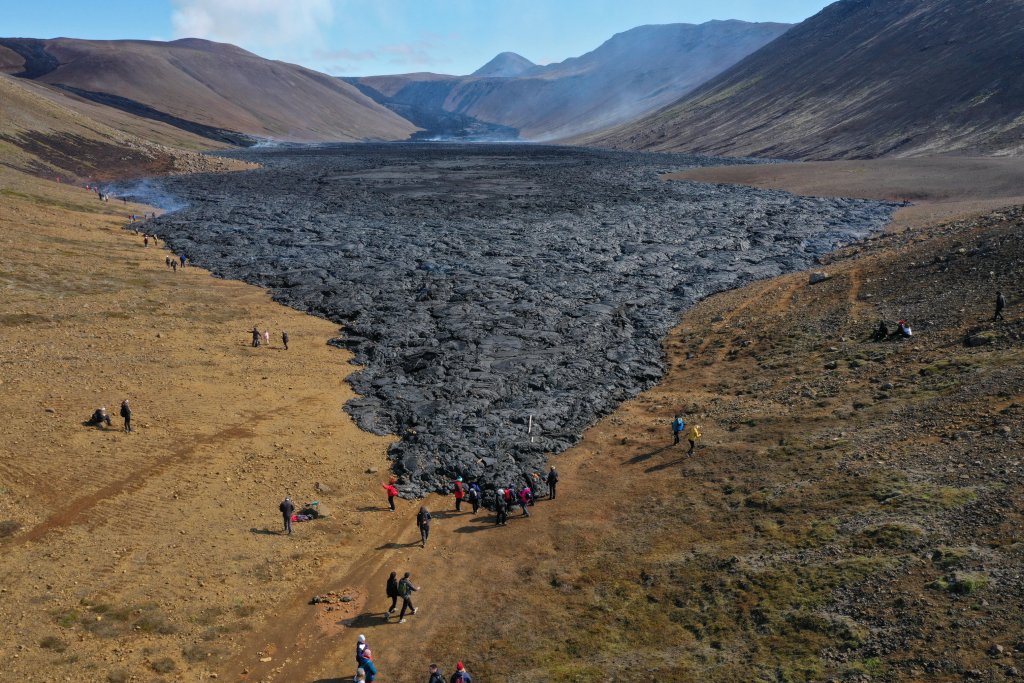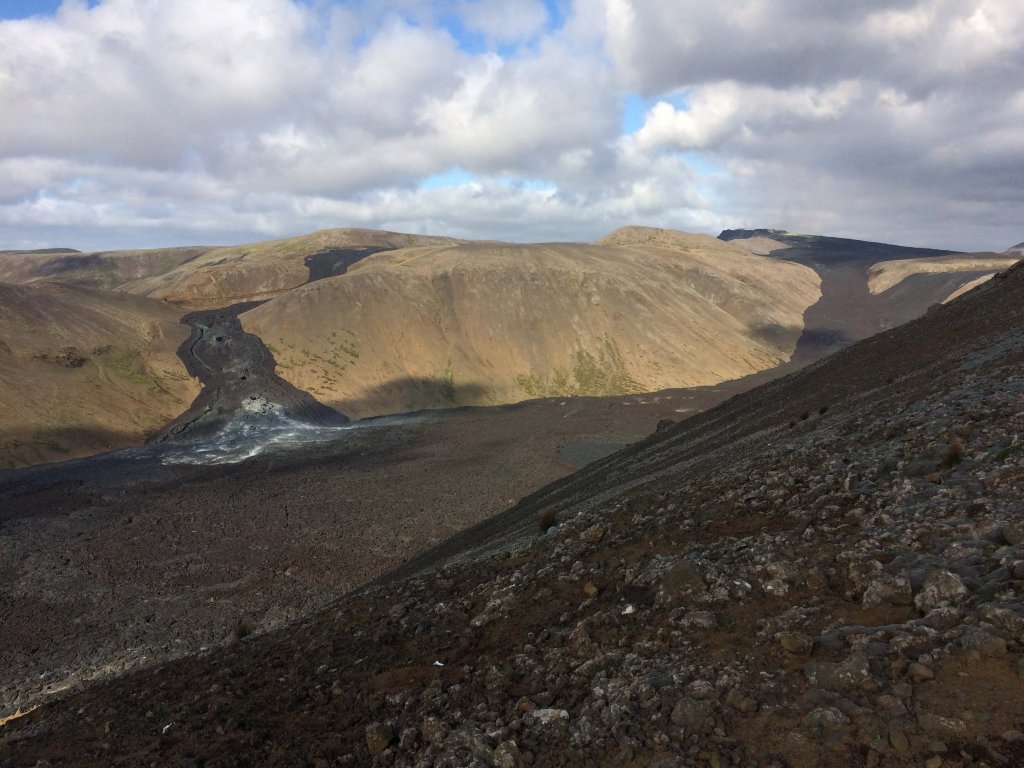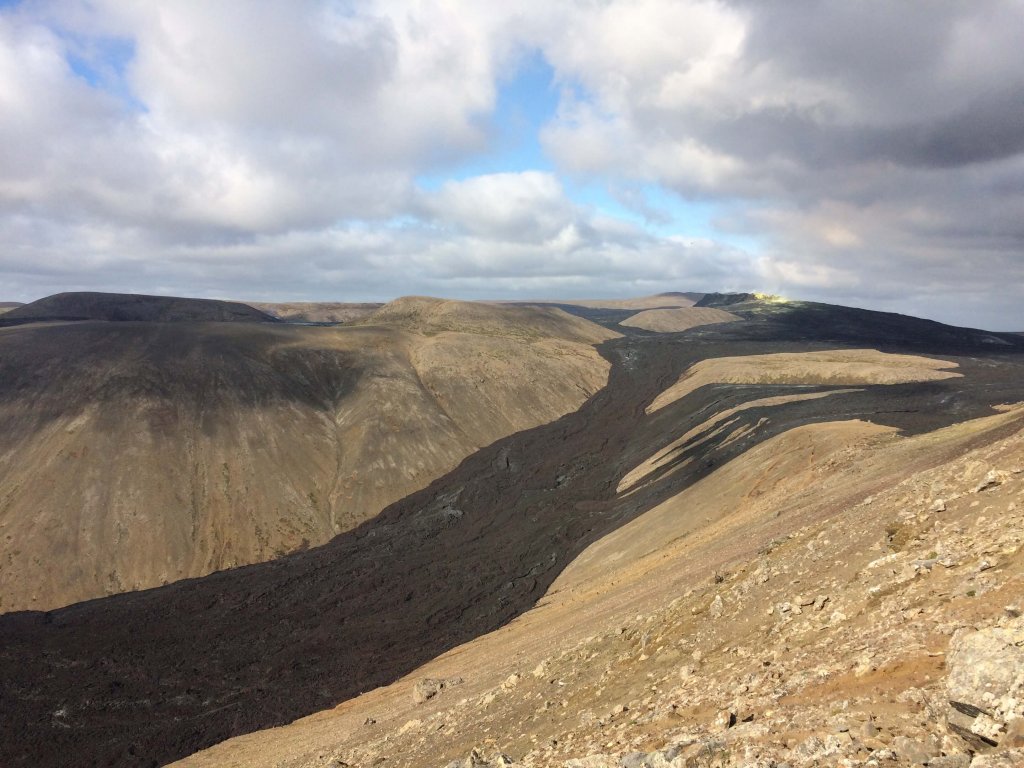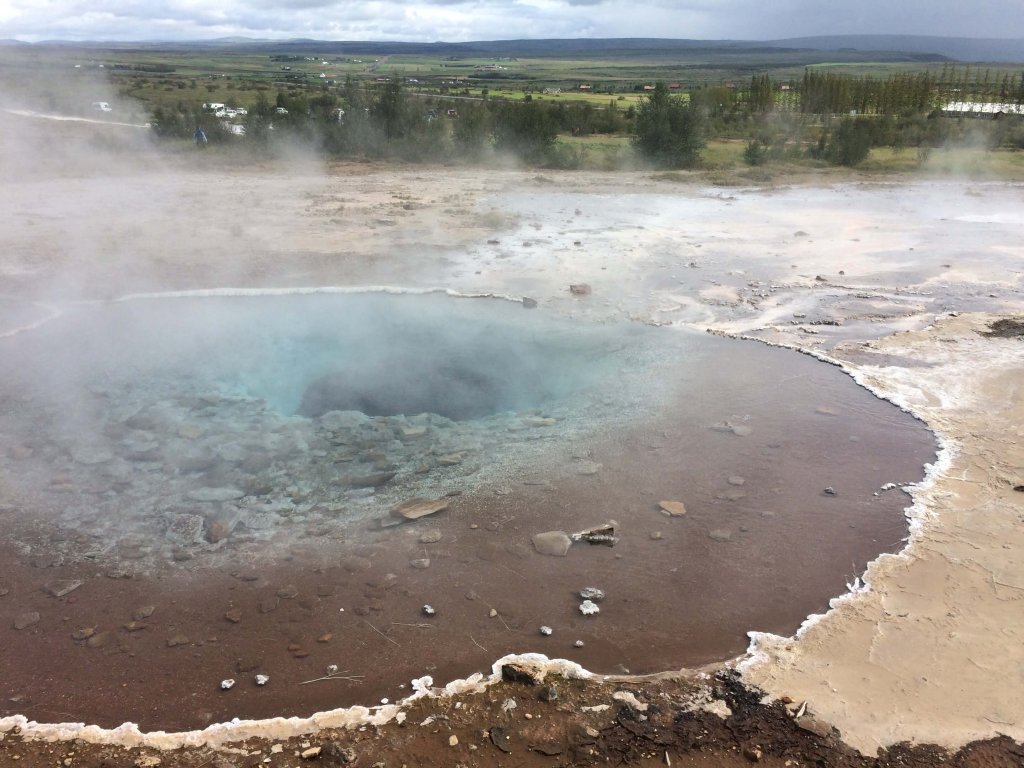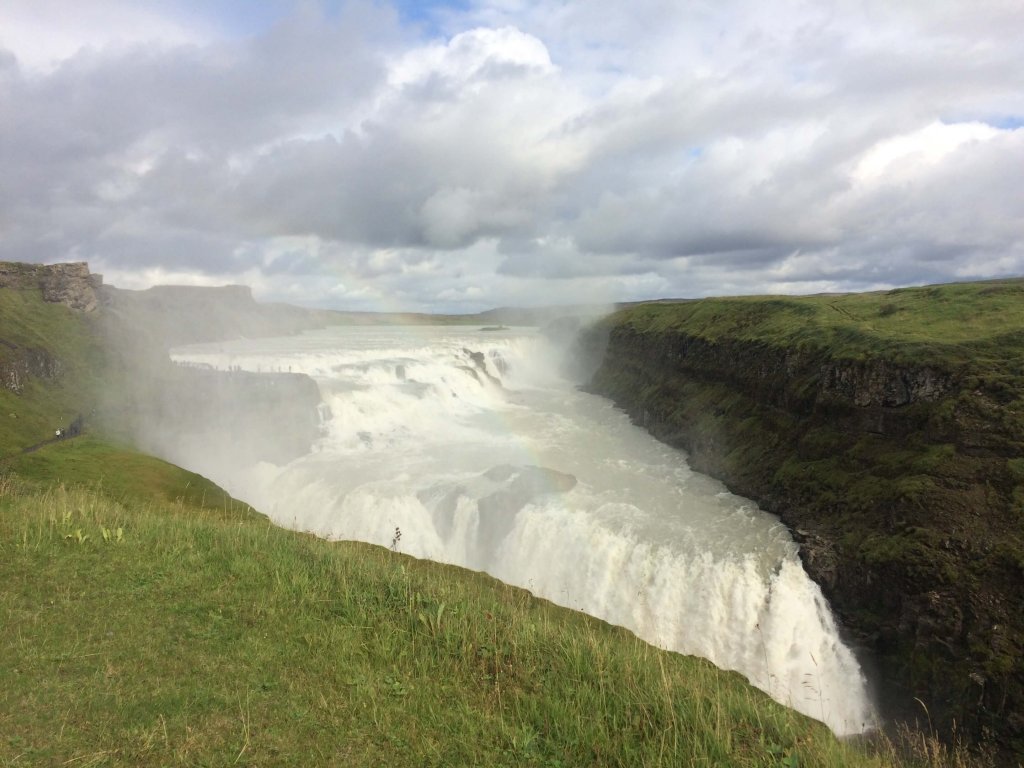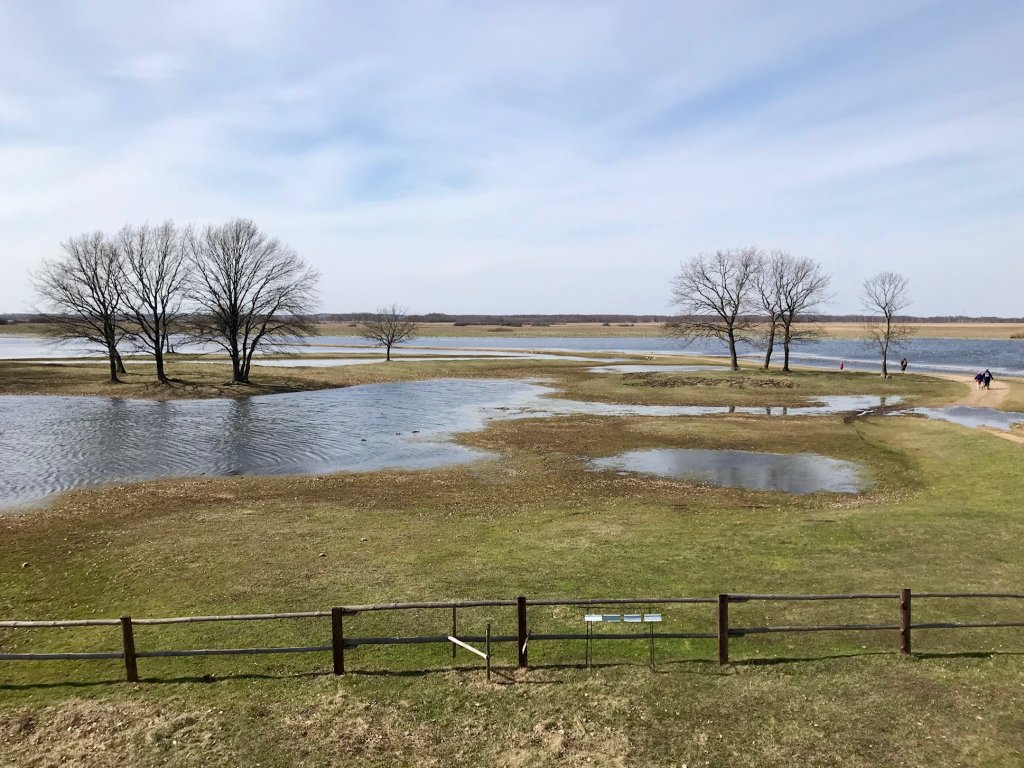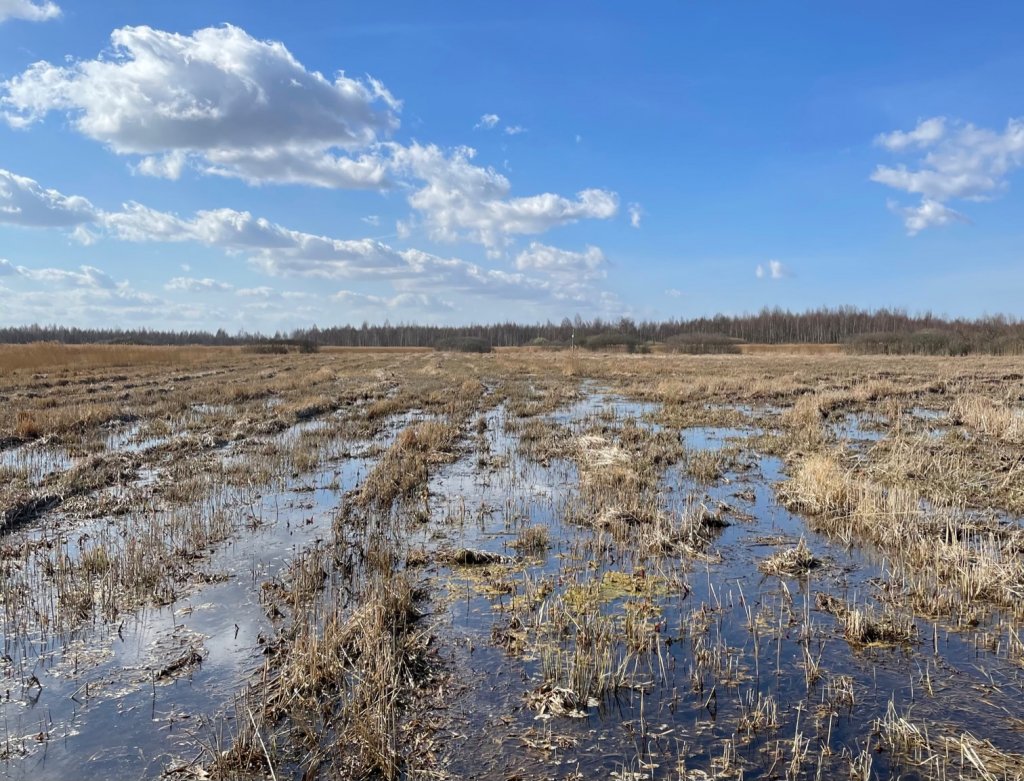An Atmosphere Black with Carbon
Since the outbreak of the Industrial Revolution, we have emitted nearly two and a half trillion tonnes of carbon dioxide into the atmosphere. Now we rack our brains how to push them underground.
I was so excited that night, I couldn’t sleep, recalls Michał Horodyski, a public transit worker from Reykjavik. “Finally, I got up, got in my car and drove to the volcano. In the darkness, I climbed the peaks leading to it, illuminating my way with a headlamp. There were no paths yet, the authorities had not had time to set up parking lots. But people already wanted to see the eruption. In the cold night, its blazing red looked phenomenal. The glow was visible from Reykjavik.”
The Fagradalsfjall volcano (which means “mountain in a beautiful valley” in Icelandic) is located fifty kilometres southwest of the capital of Iceland. It woke up on the evening of March 19, 2021, after more than six thousand years of sleep. Michał rushed to see it two days later.
When at the beginning of September we cover almost the same route together, the harsh alpine-tundra landscape is already a little civilized. Icelandic Mount Doom has taken a break and isn’t throwing lava flows from its bowels (to my chagrin, it will let loose shortly after my departure, only to fall asleep again a month later). The weather is so wonderful that I wonder where the famous Icelandic Low went. The sun is blazing and even the ocean chill doesn’t bother us. I am happy to breathe the crisp air that smells of salt, fish, and algae decaying on pebbly beaches. We’re walking, and that’s really all that matters. Left, right, mind the rocks. Slightly uphill, actually without much effort. I’d love to hike here more.
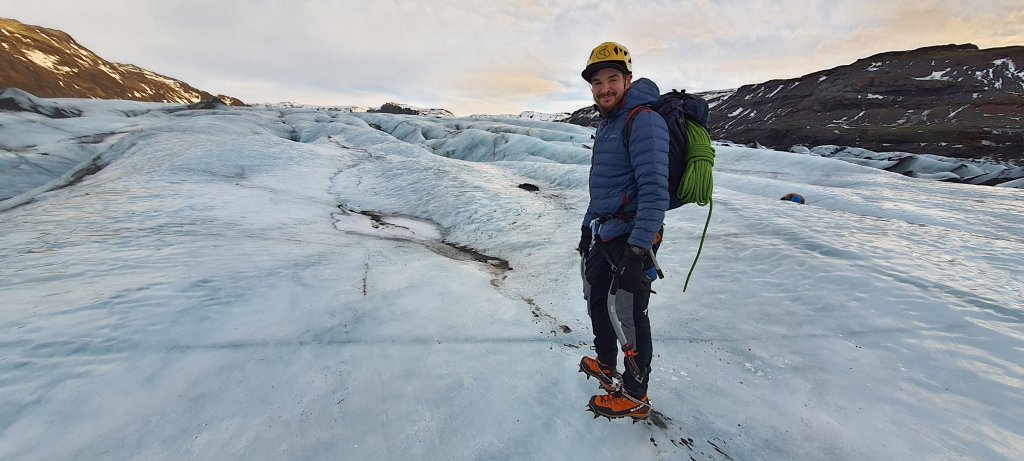
A basalt avalanche has overrun the neighbouring valleys in long flows, stopping at the earthwork dam which the Icelanders had built to prevent it from cutting across road 427 running along the ocean coast. Greyish blacks are marked by yellow-green boogers of sulphur. Here and there, grey smoke rises above the frozen lava. “It smells like a leaky coal furnace,” sums up Michał, who comes from Kraków, so he knows what he’s talking about.
The eruption of Fagradalsfjall has become a great tourist attraction. The car parks are already designated, the paths have been set, the webcam is up. Set on the nameless peak we climbed, the mobile phone mast is surrounded by a few dozen people. But there is so much space that no one gets in anybody’s way. Every now and then, my ears pick up the rustle of Polish. From above, we can see the frozen flows of lava – a lake in all shades of black. There must still be lots of heat underneath. The basalt is hot, maybe not glowing, but hot enough to denature the proteins that make up my body. Icelandic mountain rescue service have declared that they will not save anyone who enters the avalanche site and gets stuck. It’s too dangerous.
Light planes, helicopters, and drones make passes over the recently formed crater. Michał, although he himself had flown over the volcano in an airplane, sums up this aerial gathering with a profanity. We tolerate people around us, but we do not like the machines, which detract from the pristine, post-apocalyptic landscape, overly civilizing its austerity. They buzz, they annoy, they pollute the air with engine secretions. They disturb the black silence. They infantilize.
On the way to the volcano, we drove through the fishing town of Grindavik, inhabited by just over three thousand people. Nearby is Bláa Lónið, or the Blue Lagoon, a popular outdoor spa created with waste water from a nearby geothermal power plant. It attracts not only tourists, but also locals. In the milky-blue water, its colour due to the high content of silica, temperature reaching nearly 40 degrees Celsius, social life happens, up to and including, I am told, close encounters of the third kind. The town of Grindavik itself won a plebiscite for the happiest town in Iceland three years ago, but in March 2021, just before the Fagradalsfjall eruption, the earth there was shaking two thousand times a day. The inhabitants were fed up.
“This is the happiest town at the moment for two reasons,” laughs Michał, as we eat a nice lobster soup in the coastal Bryggjan Kaffihus (you pour it yourself from a large cauldron, trying to drain off the thin stuff and keep as much thick as possible in the ladle). “Because it won the plebiscite and the earth isn’t shaking anymore!” In addition to the port and a sports centre with a geothermal swimming pool, Grindavik is composed primarily of single-family houses. No wonder it’s nice living here.
On our way to the capital of Iceland, we go down a gravel road covered with black volcanic slag. There’s a lot of roads like this here. The pebbles rattle, hitting the metal of the chassis and the interior of the mudguards. We are headed for the lava cave of Leiðarendi.
Leiðarendi is only two thousand years old. Such caves are created when the lower layer of magma flows out of the tunnel it has created and the upper one freezes, forming a vault. Shining our headlamps, we struggle over fragments of lava crust, which through water erosion broke off and fell to the bottom of the cave. Leiðarendi is 900 meters long, but it still feels like we are descending into the centre of the world.
We can hear someone behind us. “Gentlemen, are you going to the exit?” he asks in Polish as he catches up with us. I lose my bearings for a moment. Are we going deeper into the cave, or are we heading out? My inner ear points me one way, then the other. I shake the feeling off. The man has probably closed a loop in the connected corridors of Leiðarendi. We point him to the surface.
Carbon In and Around Us
The Reykjanes Peninsula is Iceland’s geologically youngest region. Here, the mighty Mid-Atlantic Ridge emerges from beneath the surface of the ocean. The lava surfacing between the North American and Eurasian tectonic plates, which are spreading apart at the bottom of the Atlantic, forms the foundations of Iceland. The ground cracks along the entire island, a rift cutting across it from the southwest to the northeast. Across this crack, you can go from Europe to America and back in a few moments. You can even stand between the two continents.
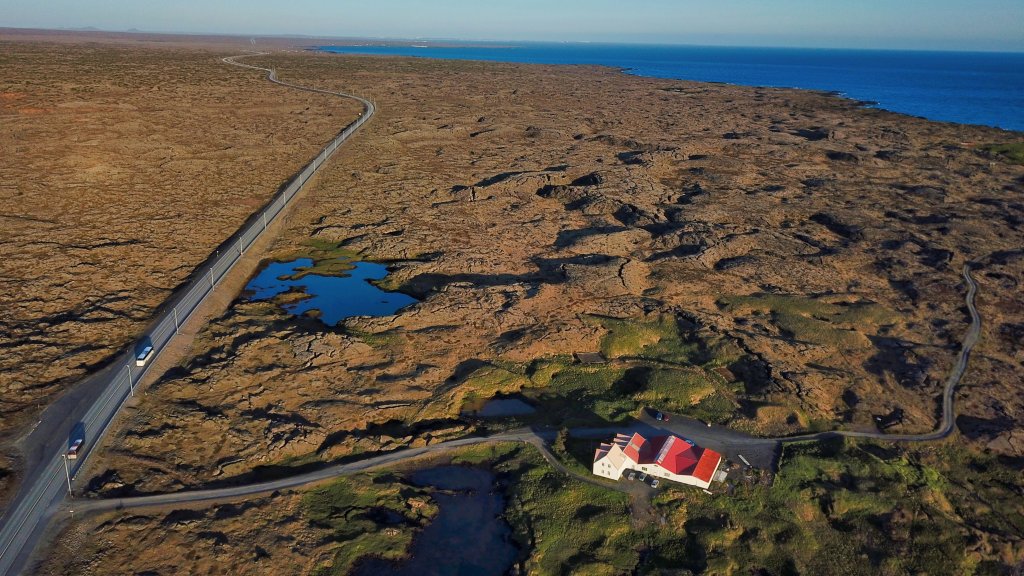
All of Iceland is volcanically active, but the rift is the hottest. The local volcanoes are one of the natural gates through which carbon, the fourth most common element in the Universe (after hydrogen, helium, and oxygen), enters the atmosphere in the form of carbon dioxide (CO2). The carbon we have on Earth was forged in the thermonuclear fusion of aging stars. Exploding as supernovas, they scattered it across the cosmos. On Earth, carbon circulates in the environment in a never-ending cycle. Organisms also take part in this cycle, because – as biologists are known to quip – life is nothing more than an arrangement of carbon atoms. They form the skeleton, to which other elements can easily attach, building amino acids, and from them – proteins. Hence, organic chemistry is the science of carbon compounds.
They make up our diet, and one of the processes by which we get rid of carbon atoms from our bodies is breathing. Every year, we expel tens of kilograms of this element into the air by respiration; an order of magnitude less, we excrete in the form of faces, urine, sweat, and flatulence. Matter merely flows through us, kept in the confines of the human form by the matrix of our DNA. When, after repeated and less-than-perfect copying of this genetic information carrier, my cells are so degraded that the energy of the bonds between their atoms is no longer able to keep my organism working, I will die. My body – or actually not mine, because I will be gone – will then perhaps be cremated, and the carbon atoms forming it, after combining with oxygen atoms in a violent combustion reaction, will fly away into the atmosphere in the form of CO2. Like a soul to heaven.
The human body consists of almost 18 percent carbon (the rest of the elements that build us are primarily oxygen and hydrogen, constituting the water that makes up nearly 65 percent of a human). So, in my body there are currently 13 kilograms of carbon – unless I gained some weight over the winter. The atomic mass of carbon is rounded to 12 u, and that of oxygen – to 16 u (from “atomic mass unit”). The molecular mass of carbon dioxide is therefore 44 u (12 + 2 x 16), which means that the CO2 molecule is almost four times heavier than a carbon atom.
So if I were to expire now, and no-longer-my body were burned, almost 48 kilograms of carbon dioxide would be released into the air. In turn, if until-recently-my family decided to bury it, 13 kilograms of carbon together with the rest of formerly-my matter would be absorbed by invertebrates and microorganisms and thus reintroduced into the carousel of life. Carbon, whose atoms once formed the elemental skeleton of my body, would then pass to other, including larger, organisms.
This is nature’s so-called fast carbon cycle, measured in lifetimes. According to Earth Observatory, an official outlet of NASA (the US National Aeronautics and Space Administration), scientists estimate that between a billion and a hundred billion tonnes of this element flow through the Earth’s biosphere every year. Ashes to ashes, dust to dust.
It can happen that carbon atoms break out of the organic circuit and enter the water or atmosphere for a longer time, e.g. in the form of CO2. Such a molecule can stay in the atmosphere for a little over a hundred years. By then, it is most likely either absorbed back by photosynthesizing algae and plants (and from them it goes into the organisms of animals, including humans), or, via air bubbles, absorbed by sea waves or washed out of the air by rain. In combination with rainwater, CO2 creates a weak solution of carbonic acid that dissolves rocks and, together with washed out ions of some elements, including calcium, flows into soil, rivers, lakes, and the ocean. In the ocean, calcium ions react with bicarbonate ions to form calcium carbonate, which planktonic organisms and corals use to build their shells or internal skeletons. When these in turn die, they sink to the bottom of the ocean, where they are covered with successive layers of dead organisms. Their remains are compressed into limestone for millions of years, which in the mill of collision and subduction of tectonic plates (i.e. pulling or pushing one plate under or over another) can reach the upper layers of the Earth’s mantle, where it melts under the influence of temperature and pressure, creating minerals called silicates and releasing carbon dioxide. The CO2 molecules are then carried by the magma to the cracks of the Earth’s crust – among others, the ones in Iceland – and fly back into the air through volcanoes.
This is what’s called the slow carbon cycle. The journey of a carbon atom between the atmosphere, rocks, soil, the hydrosphere, and the atmosphere again takes as much as one hundred to two hundred million years. Scientists estimate that all the volcanoes in the world emit between 130 million and 380 million tonnes of carbon dioxide per year.
However, part of the carbon from dead algae, plants, and animals remains stuck in rocks and sediments for hundreds of millions of years. Dead organisms that enter marine sediments, under the influence of temperature and pressure, then decay into kerogen, and from it transform into oil and natural gas. In turn, the remains of land plants form peat, which over time transforms into lignite, and then into coal and natural gas. The formation of the latter – whose main component is methane (CH4) – partly involves underground anaerobic microorganisms.
Coal (carbon plus impurities), crude oil (carbon and hydrogen with a small admixture of other elements) and natural gas (methane plus impurities) are therefore remnants of organisms that died hundreds of millions of years ago, converted by pressure, heat, and microbes. For us, they are also high-energy fossil fuels. Since the industrial revolution, which broke out in the middle of the 18th century, we have been mass-producing and burning them to obtain heat energy in a rapid reaction of carbon or hydrogen with oxygen, some of which we convert into other forms of energy: electrical and mechanical. By doing so, we are returning to the air a greenhouse gas, carbon dioxide, whose fluctuations in atmospheric concentration have always caused global warming and cooling.
In 2021 alone, our civilization pumped more than 36 billion tonnes of CO2 from the burning of fossil fuels into the air (making up for the dip in emissions in 2020 associated with the COVID-19 pandemic), which is almost three hundred times more than did Iceland’s Fagradalsfjall together with all the other volcanoes in the world. If we add to this the carbon released in cement and steel production, as well as that from harvesting forests and other ecosystems, we end up with nearly 40 billion tonnes of carbon dioxide. And when we add other greenhouse gases, including methane, and we convert their heating power into carbon dioxide equivalent (CO2e), it turns out that our civilization defecates about 50 billion tonnes of CO2e into the atmosphere every year.
Although the nineteenth-century bleak visions of cities choking with horse manure have not come true, we are polluting the air with the excrement of our civilization on a scale unprecedented in human history. Since the outbreak of the industrial revolution, we have burned so much fossil fuels, cut down so many forests, and dried up so many peat bogs and swamps that we have emitted a total of about 2.4 trillion tonnes of carbon dioxide (654 billion tonnes of carbon, because let us remember that the molecular mass of CO2 is almost four times the atomic mass of C). Only in the last half-century have we pumped as much of this greenhouse gas into the air as in the previous two centuries. Scientists studying the Anthropocene call this period the Great Acceleration (of the development of civilization and the growth of the economy). Climate scientists have calculated that more than 20 percent of mankind’s CO2 emissions are absorbed by the ocean and 30 percent by terrestrial plants. That leaves almost half in the atmosphere.
Orca to the Rescue
Before 7 am on Wednesday, September 8, 2021, I am waiting for a city bus on the outskirts of Reykjavik.
The morning is brisk and enchanting. I smell the ocean again. Nearby mountains fray the low, wispy clouds. The rising sun tints the air orange. I breathe it in deeply. It seems pristinely pure. There’s absolutely no one in the streets. In such moments, one forgets about the ecological and climatic catastrophe that mankind is inflicting on itself, and about which the famous David Attenborough talks so poignantly in the film and the book A Life on Our Planet.
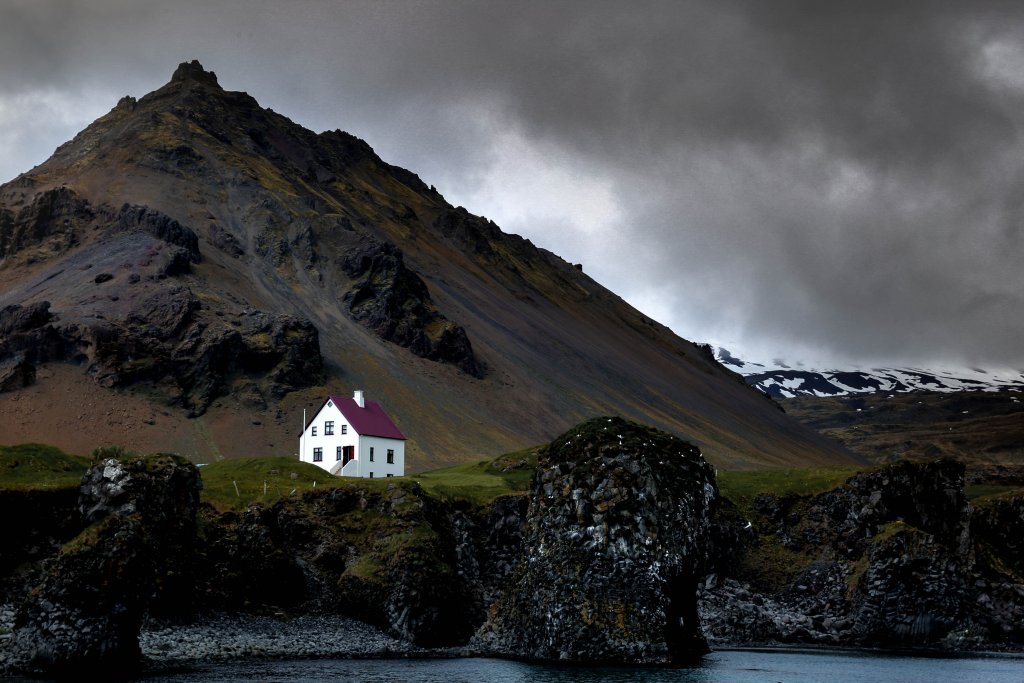
After a few minutes, I board the bus number six, which will take me to the city centre. Inside, just a smiling, moustached driver, whom I pay for a ticket by tossing 490 krónur into a plexiglass money box. He doesn’t even count it.
– Attention, number sixteen drivers… – the dispatcher chatters in Polish. According to Hagstofa Íslands (Iceland’s Central Statistical Office), Poles constitute almost 6 percent of the island’s approximately 370,000 inhabitants, and 40 percent of all resident aliens. Michał Horodyski, who is also a bus driver in Reykjavik, jokes that Iceland will soon become the seventeenth voivodeship of Poland, and he will travel between the two countries by taking off and landing at national-trip airports. When I later tell this joke to an Icelander, he looks hesitant.
We pass between empty housing estates of single-family homes, with captivating volcanic rock gardens “growing” around them – broken basalt slabs covered with sparse vegetation. Downtown, I transfer to a coach chartered for journalists by a Swiss company called Climeworks. Today is its big day, the ceremonial launch of the Orca installation (orka is Icelandic for “energy”). Its construction began in May 2020, and today it is supposed to start capturing four thousand tonnes of carbon dioxide per year from the air. Afterwards, devices of the Icelandic company Carbfix will saturate water with the captured CO2, just like a giant soda siphon, and pump the fizzy under the surface of the Earth. There, it will react with basalt rocks, forming a mineral called calcite.
“We turn CO2 into rock” – say Climeworks, and I, when I hear this slogan, am reminded of an advertisement of a local liquor. A beautiful Icelandic woman is drifting on an ice floe, reciting in English with a harsh but charming Scandinavian accent: “In Iceland, we turn water into vodka”.
We are driven to the nearby Hellisheiði power plant, which draws hot water through dozens of wells, some of which reach more than three kilometres into the Earth. The largest installation of this kind in Iceland, launched in 2006, it supplies Reykjavik with electricity and hot water (very hot, as the temperature of the water in the taps in Iceland reaches 80 degrees Celsius and you have to be careful not to get scalded). Like other Icelandic geothermal power plants, it is noticeable from a distance – thanks to a rising plume of condensed water vapour. It roils and belches like a steam locomotive.
Hot and explosive mud springs in the Gunnuhver area of the Reykjanes Peninsula, video by Tomasz Ulanowski
In my mind, I laugh at the thought that the typical Icelandic cloud cover may be caused not by low pressure centres whirling over the island, but by geothermal sources and installations, the earth around them seething with energy of water changing phase from liquid to gas and back. Similar clouds of steam rising from Bełchatów or other coal or lignite-fired power plants usually depress me. Here, they do quite the opposite. Boiling ponds and puddles, as well as the fruits of human ingenuity, fill me with delight.
In the conference room, above 150 chairs, wafts a delicate smell of sulphur. Hot water extracted from Iceland’s depths is saturated with hydrogen sulphide (H2S) and carbon dioxide. The power plant’s equipment traps these gases and pushes them back underground, where, in reaction with the rocks, H2S is transformed into pyrite, a mineral whose colour earned it the moniker “fools’ gold”.
Before we go see Climeworks and Carbfix’s installations, there are official speeches to be made. Iceland’s former president, the grey-haired Ólafur Ragnar Grímsson, speaks like at a rally. He warns that climate change will sink large agglomerations. He makes out that Iceland is the only place where America and Eurasia meet. “Rather, where they split apart!” we joke with two Slovenian journalists sitting next to us. What Grímsson means, however, is probably the money. Bill Gates has invested in Climeworks ($60 million, according to my Slovenes). In turn, the European Commission pumped 2.2 million euros into the company’s pilot project of 2017. That installation, also in Hellisheiði, captured 50 tonnes of carbon dioxide from the air per year – 80 times less than Orca is supposed to collect.
Let’s put these numbers in a more human perspective. In 2021, in the European Union alone, we burned so much fossil fuels that we emitted 2.8 billion tonnes of carbon dioxide into the atmosphere, or six tonnes per capita. China, the largest emitter of this greenhouse gas to the atmosphere for over a decade, has sent up 11.1 billion tonnes, which is nearly eight tonnes per a Chinese national, and the US – 5.1 billion tonnes, an average American responsible for 15 tonnes. Orca, which is supposed to take 4 000 tonnes of carbon dioxide out of the atmosphere every year, will therefore compensate for the emissions of 667 Europeans. Or 500 Chinese. Or 267 Americans.
That’s low.
Of course, this is one of the first such installations. Katrín Jakobsdóttir, the head of Iceland’s government, enters the stage after the former president (he looks like a skilled demagogue, she rather has the style of a focused professional). She emphasizes that the world will need many similar plants like Orca, but large-scale ones, for direct air capture (DAC) of carbon dioxide, in addition to those capturing CO2 from stacks and pushing it underground (CCS – carbon capture and storage).
Orca from a bird’s-eye view, press materials / Climeworks
According to the latest, sixth report of the Intergovernmental Panel on Climate Change (IPCC), global warming will reach 1–5.7 degrees Celsius by the end of the 21st century. This range depends on further emissions of carbon dioxide and other greenhouse gases. Four years ago, IPCC scientists calculated that if we want to even dream of stopping global warming at a bearable 1.5 degrees Celsius in this century, we must reduce greenhouse gas emissions by 45 percent by 2030 and to zero by 2050.
Following this lead, the International Energy Agency (IEA) developed a plan Net zero by 2050, about which I wrote in the first part of the Earth Lens series [Editor’s note: issue 2/2022]. “Net zero” means that the emission balance must be zero. So we can emit some carbon dioxide and other greenhouse gases, but their CO2 equivalent should be simultaneously removed from the atmosphere or captured right from the chimneys of power plants and industrial plants. Part of the carbon captured in this way can be combined with hydrogen and converted into synthetic fuels, used where today’s fossil fuels cannot be replaced, for example in aviation or ammonia synthesis (for fertilizer and fuel). The IEA plan projects that by mid-century we will still emit nearly 8 billion tonnes of carbon per year. In order to capture that much from the atmosphere with current technology, we would need nearly 2 million installations like Orca.
The Canadian company Carbon Engineering, which has been experimenting with removing carbon dioxide from the air in British Columbia since 2015, is planning to build an installation in Scotland with the British company Storegga, which will capture one million tonnes of CO2 per year, 250 times more than Orca. As Carbon Engineering boasts, that’s the amount absorbed annually by 40 million trees. By 2050, we will need “only” eight thousand such “carbon farms”.
Given the scale of the demand, it is hardly surprising that Dr Amy Ruddock, vice president of Carbon Engineering for Europe, claims that her company does not treat Climeworks or other similar investments as competitors. She’s diplomatic when we talk after I get back from Iceland: “In the business of negative carbon dioxide emissions, demand exceeds supply. So we prefer to perceive other initiatives as colleagues,” she smiles. “It’s all hands on deck. We will not tackle climate change otherwise. Therefore, unlike Climeworks, we decided to sell licenses for the use of our technology. This is the only way if we want to think about capturing billions of tonnes of CO2 out of the air. Many installations around the world are needed. We can’t do it all ourselves.”

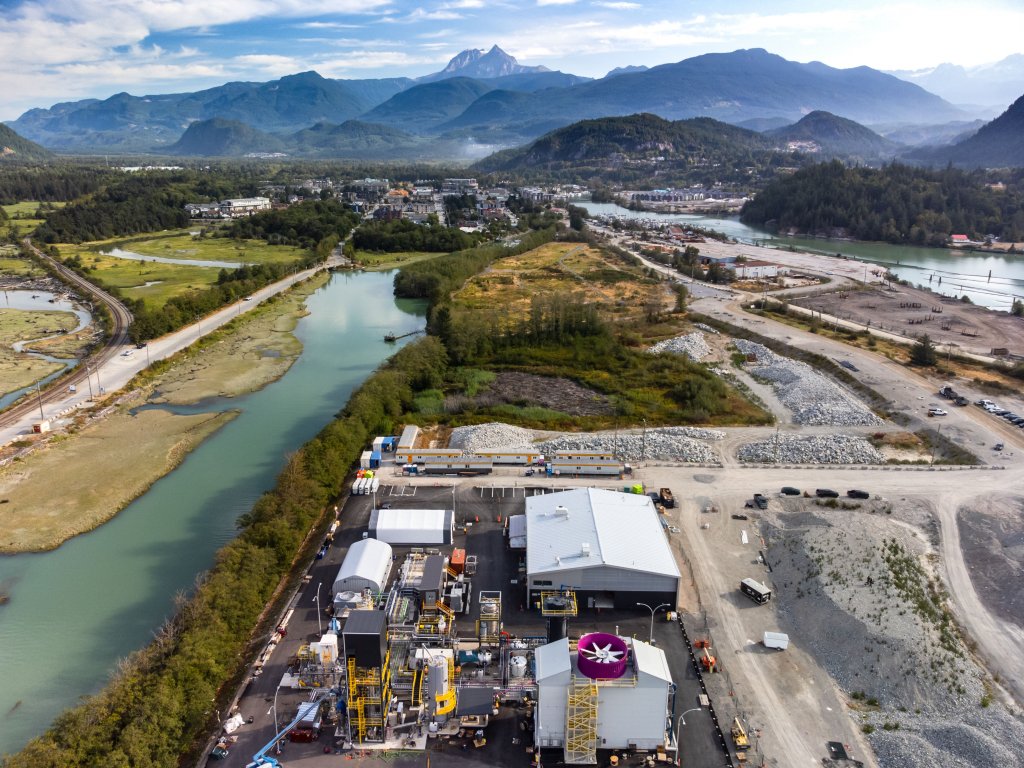
In November 2021, the European Commission announced the financing for further experimental installations. It intends to do so in partnership with Bill Gates’ Breakthrough Energy project and the European Investment Bank. As a result, in the next few years, €820 million will be injected into the development of innovative technologies for combating global warming. The Commission also hopes that public spending will attract three times more money from private funds. In the years 2022–2026, the EU will organise tenders to select companies that may take advantage of public funding in this program. Funds will be allocated not only to technologies for direct capture of CO2 from the air, but also to energy storage, production of so-called green hydrogen (using renewable energy sources) [Editor’s note: Justyna Piszczatowska wrote about it in Pismo, issue 12/2020], and “sustainable” aviation fuel, e.g. produced partly from waste.
Why can’t we only stop emitting carbon dioxide, but we also have to get it out of the air? Although it is possible to completely abandon fossil fuels in the production of electricity and heat by replacing them with renewable sources (mainly through solar and wind power plants) and nuclear energy (as I wrote in the first part of the Earth Lens series), we are not yet able to manufacture several products necessary for our civilization without using coal, oil, or natural gas.
We use coal to produce steel and cement, which, as Bill Gates points out in his book How to Avoid a Climate Disaster, is now responsible for 10 percent of all greenhouse gas emissions. Gates explains: “To make cement, you need calcium. To get calcium, you start with limestone—which contains calcium plus carbon and oxygen—and burn it in a furnace along with some other materials. Given the presence of carbon and oxygen, you can probably see where this is going. After burning the limestone, you end up with the thing you want—calcium for your cement—plus something you don’t want: carbon dioxide. Nobody knows of a way to make cement without going through this process. It’s a chemical reaction—limestone plus heat equals calcium oxide plus carbon dioxide—and there’s no way around it. It’s a one-to-one relationship. Make a ton of cement, and you’ll get a ton of carbon dioxide.”
In turn, “[to] make steel, you need to separate the oxygen from the iron and add a tiny bit of carbon. You can accomplish both at the same time by melting iron ore at very high temperatures (1,700 degrees Celsius or over 3,000 degrees Fahrenheit), in the presence of oxygen and a type of coal called coke. At those temperatures, the iron ore releases its oxygen, and the coke releases its carbon. A bit of the carbon bonds with the iron, forming the steel we want, and the rest of the carbon grabs onto the oxygen, forming a by-product we don’t want: carbon dioxide. Quite a bit of carbon dioxide, in fact. Making 1 ton of steel produces about 1.8 tons of carbon dioxide.”
Currently, manufacturers are starting to experiment with obtaining the temperature necessary for steel and cement production using electricity or environmentally friendly hydrogen, but it is impossible to circumvent the fact that carbon must be extracted from limestone and added to iron. Concrete, in turn, the production of which uses both cement and steel, is today’s second most commonly used material in the world (after water). It accounts for four-fifths of the mass we have put into our technosphere, whose combined mass in 2020 has exceeded the biomass of all earthly organisms. As a group of Anthropocene researchers calculated a few years ago, we have poured nearly 500 billion tonnes of concrete on the Earth (almost all of it in the last seventy years). For every square meter of our planet there currently exists a kilogram of concrete.
Compared to concrete, plastic is a material that is still marginal, although more and more popular. Since the middle of the 20th century, we have produced over eight billion tonnes. As the Anthropocene experts have estimated, that is enough to foil-wrap the entire Earth. Plastics are derivatives of petroleum. Their production is currently responsible for 6 percent of world oil consumption.
Natural gas, in turn, is used to extract nitrogen from the air. The resulting ammonia is mainly made into artificial fertilizers. Unfortunately, carbon dioxide is one of the by-products. Research on synthesizing ammonia without the use of fossil fuels is also still in its infancy.
If we do not come up with alternative industrial methods of steel, cement, plastic, and fertilizer production, we will have to capture the carbon dioxide as it’s generated in those processes. Or remove an equivalent amount from the air.
Meanwhile, the mayor of Reykjavik, Dagur Bergþóruson Eggertsson, enters the stage in the conference room of the Hellisheiði power plant. He boasts that the capital of Iceland will become one of the first zero-emission cities in the world.
It stands a good chance, because thanks to the extraordinary geothermal potential, Reykjavik already has a head start. Almost all buildings are connected to the municipal heating network, whose pipes are a total of three thousand kilometres long. It is either fed directly with geothermal water, smelling of hydrogen sulphide, or surface water heated in heat exchangers up to 80 degrees by water obtained from underground sources (whose temperature of several hundred degrees is made possible by high pressure keeping it in a liquid state). To think that a hundred years ago, the city was heated by imported coal.
The Vikings, who came here at the end of the 9th century from Scandinavia, which lacked active volcanoes, initially treated the surface hot springs with suspicion – as gateways to hell. However, they quickly learned to use them (the baptism of the first Icelanders in 1000 CE took place in hot springs, which is hardly surprising, as the temperature of sea water even in summer is only a few degrees), and the final impulse for their widespread use was the fuel crisis of the 1970s. Currently, 90 per cent of homes in Iceland are heated geothermally; the same percentage of energy production in the country is provided by renewable sources. This is a ratio currently unattainable by other countries.
A staff member turns on the monitor, from which another speaker, dressed like a cowboy (or a Mexican vaquero), Dr Julio Friedmann from the University of Columbia in New York, an expert in removing carbon dioxide from the atmosphere and the ocean, smiles at us. He has no doubt that in a few decades we will be pulling many times more CO2 out of the air. DAC installations will be everywhere, as will solar panels and wind turbines. We will create a new industry the size of today’s fossil fuel industry. The task of this new one will be to correct the mistakes made by the old one. That’s how we’re going to produce wealth. Later, I want to ask him about it, find out what reasons he has for being so optimistic, but he won’t answer my emails.
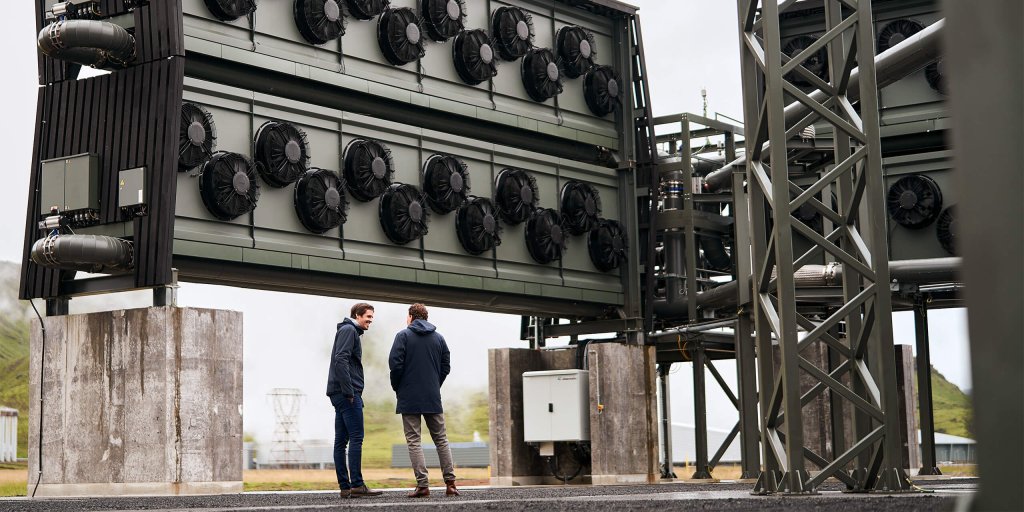
Dr Jan Wurzbacher and Dr Christoph Gebald, the co-founders of Climeworks (whom for my own use I call the two-headed dragon – they complement each other so well) have no doubts about the promised land of the new “carbon industry”. They tell the story of how they began their work on removing carbon dioxide from the air twelve years earlier, when they met at ETHZ, the famous Federal Institute of Technology in Zürich (Eidgenössische Technische Hochschule Zürich). “We had almost nothing back then. Today we have even bigger dreams.”
They calculate that in the construction and dismantling of Orca (it is to be decommissioned and recycled after ten to fifteen years of operation), the equivalent of one tenth of the carbon removed by it will escape into the atmosphere. And that their installation is ten times more efficient than trees, both in terms of the footprint occupied by Orca and its lifetime. Both scientist-entrepreneurs assure us that as soon as in the second half of the current decade, installations worldwide will be removing not thousands but millions of tonnes of carbon dioxide from the air annually. And by mid-century, we’ll have reached the required billions of tonnes.
While waiting for a tour of Orca and the Carbfix plant, we have lunch with my Slovenian neighbours and joke that thanks to this event our carbon can also go underground. We all have our faces uncovered, like the coronavirus pandemic is over. Not long ago, during the meet-and-greet, we nearly sipped coffee through masks.
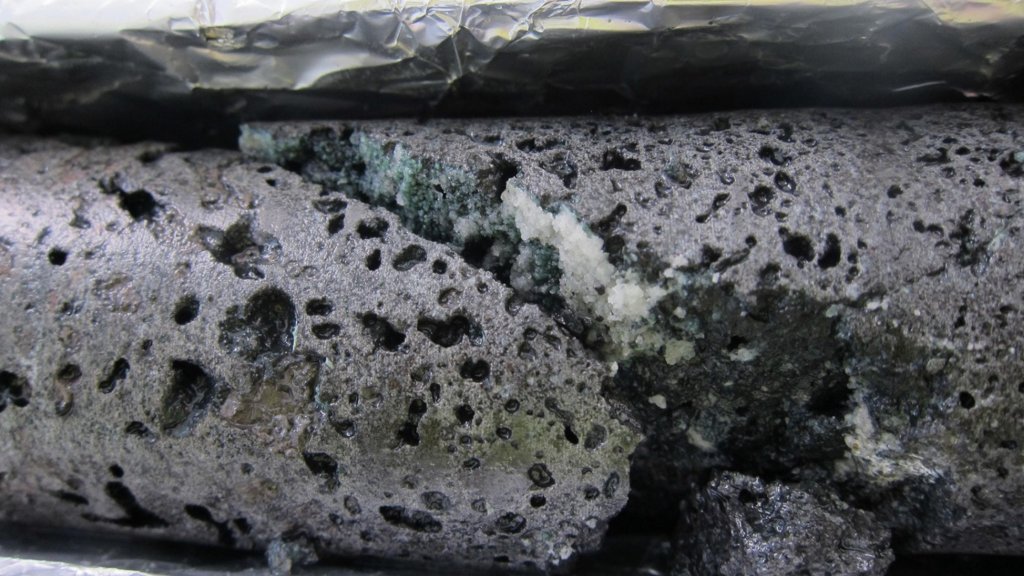
Iceland’s humid wind pierces us to the bone. The landlubber journalists curl up in their thin coats and stomp their feet dressed in fancy shoes.
We’re standing on a wet concrete floor. Our world has about the size of a tennis court. The four walls of Orca fence us in. Three are almost openwork – collector banks. The devices are arranged in pairs one on top of the other on concrete blocks and reach two storeys high. The fourth wall of the installation is a white hall, which houses a tangle of pipes moving the collected carbon dioxide. For the largest DAC installation in the world, Orca looks extremely modest and fits quite well into the surrounding, wild Icelandic landscape.
Project leader Lukas Kaufmann tells us how his baby operates. The most important part of the installation are its eight collectors, each of which will capture 500 tonnes of carbon dioxide a year. Impellers suck in the air, which passes through a special filter and leaves CO2 molecules on it. A saturated filter is heated to the temperature of about one hundred degrees Celsius and the pipeline system transfers carbon dioxide to the tank farm. Everything is supposed to work automatically and require only periodic inspections and repairs.
Kaufmann claims that he does not know what materials were used to build the filters that catch the CO2. You can’t find that out at the Climeworks press office either. To my simple question I get an evasive answer that Climeworks has developed many filters, and the one used in Iceland is very effective in the Arctic climate. It’s such a secret that you can’t even say it’s a secret.
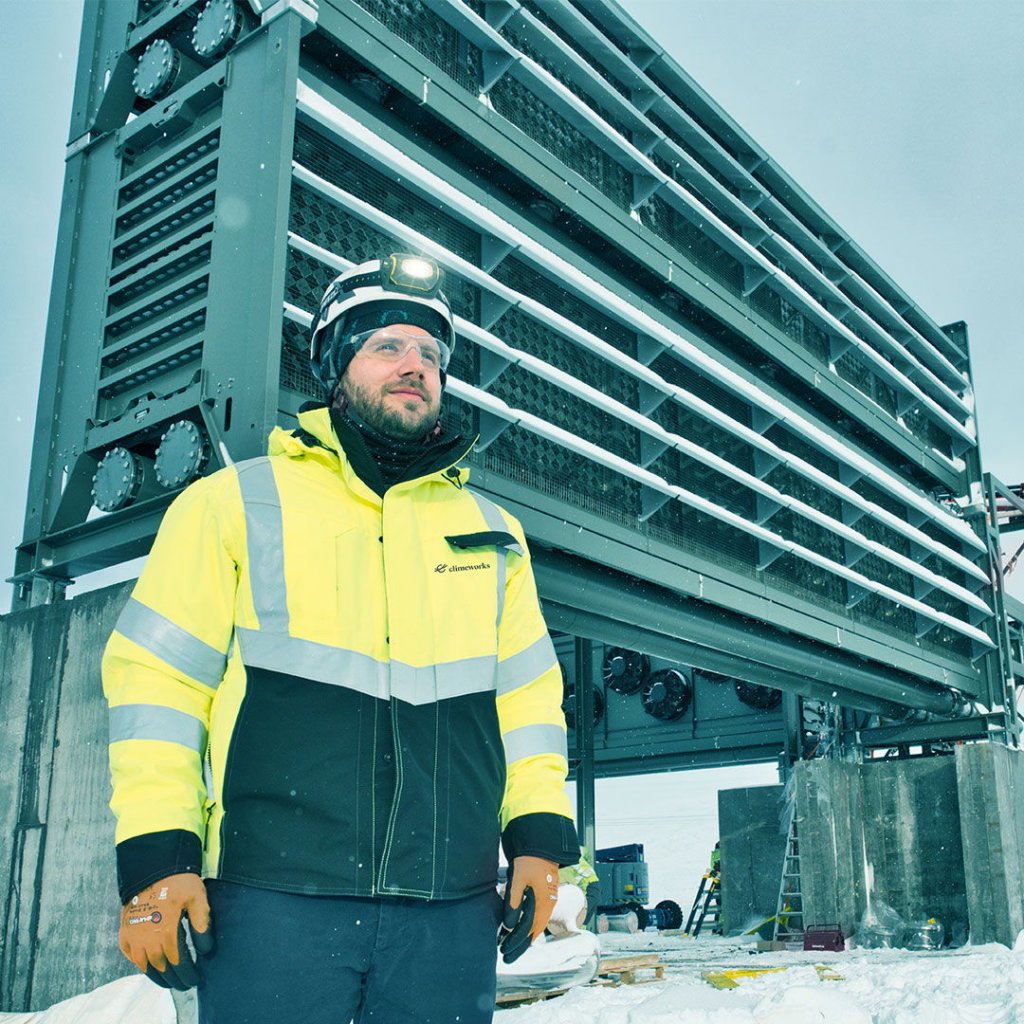
On the other hand, the Canadian company Carbon Engineering speaks and writes publicly about its technology. Its installation captures atmospheric carbon dioxide with potassium lye, an aqueous solution of potassium hydroxide. In a chemical reaction, potassium carbonate is produced, which is then dried and crushed into pellets. Heated, it releases carbon dioxide, which in turn can be pumped under the surface of the Earth or used to produce synthetic fuels. The remaining potassium hydroxide is rehydrated and reused to capture CO2 molecules.
“Carbon Engineering wanted to use a mature technology, employed for example in ore purification or the pharmaceutical industry,” Dr Amy Ruddock explains. That way, the Canadians didn’t have to reinvent the wheel. “We were able to take advantage of the already existing supply chain, which makes it much easier to start an innovative project and reduces its costs. We also wanted to recover and recycle materials, which allows us to significantly reduce the amount of waste. All this facilitates the construction of much larger installations that will be able to capture large amounts of carbon dioxide. Even a million tonnes a year, like those planned by us in Scotland and the US,” adds Ruddock.
From Climeworks’ Orca, carbon dioxide is pumped through a 3.5-kilometre gas pipeline to a Carbfix wellhead. Here, as explained by Dr Sandra Ósk Snæbjörnsdóttir, a geologist and one of the company’s managers, CO2 is mixed with water and pumped under nine bars of pressure to a depth of 700 meters. Acidic sparkling water is heavier than groundwater and spreads easily through cracks in the basalt. It reaches the sensors that monitor the process of carbon dioxide petrification. As Snæbjörnsdóttir says, this one underground well alone could accommodate up to a million tonnes of carbon dioxide per year. Orca will probably be expanded.
But what if a volcanic eruption happens here, throws magma to the surface, and all this carbon dioxide gets back into the atmosphere?
“It is possible, but very unlikely,” says the geologist. She explains that Icelandic basalts are perfectly suitable for absorbing CO2. They are so porous (a vestige of the gases that escaped into the atmosphere when red-hot magma erupted to the surface of the Earth) that in every cubic meter they could hold up to a hundred kilograms of carbon dioxide. And Iceland could accommodate all (all!) of the excess carbon dioxide that mankind has ever pumped into the atmosphere.
I buttonhole an anonymous young man representing venture capital, looking for an opportunity to invest. He believes that installations similar to Orca will soon be profitable.
“But will it be a business to match the fuel industry?”
He laughs.
“You did smell blood, didn’t you?”
“Oh, yes,” he laughs again.
Dr Amy Ruddock of Carbon Engineering tells me later that her company will follow the market. If there’s a demand for injecting atmospheric carbon dioxide underground, that’s what they will focus on. If the market favors the production of synthetic fuels, the company will move in that direction. It is also possible that they will develop both lines of the new carbon business.
However, this market will be largely controlled by governments. “All depends on the CO2 price they set,” CE vice-president for Europe says, frankly. “Perhaps such regulated markets will have a different effect in the US and in the European Union. Much also depends on the development of green hydrogen, which is in its infancy. I think that initially the markets will focus on simply removing carbon dioxide from the atmosphere and, over time, will shift focus to the production of synthetic fuels.” She explains the key economic assumptions: “The CO2 emissions market in California currently values one tonne of this greenhouse gas at nearly two hundred dollars. The US federal government is throwing $50 on top per tonne of captured and stored carbon dioxide (the value of this carbon credit is expected to rise to $85 per tonne). This allows CO2 atmospheric capture to close the business case. In the UK, a similar system is still under discussion. Hence, we’re planning to open a joint installation with Storrega only in 2026,” she explains.
The European Union is also currently just debating the price for direct air carbon dioxide capture. Under the existing EU Emissions Trading System, in which individual companies can sell their unused CO2 emission allowances, the emission price per tonne is currently around €85. That’s not enough for the existing small DAC installations to sustain themselves.
Why? On the Climeworks website, you can calculate the carbon dioxide emissions associated with your own air travel and pay for offsetting it, or even purchase an annual subscription pro bono. If you pay them to remove a tonne of carbon dioxide from the air, they remove 1.1 tonnes, because 0.1 tonnes of CO2 is the aforementioned cost of construction, operation, and decommissioning of Orca. Until recently, only certain environmental organisations offered similar services, such as planting trees.
Professor Szymon Malinowski, an atmospheric physicist and head of the special advisory team on the climate crisis to the President of the Polish Academy of Sciences, jokes that this was a kind of modern trade in indulgences. Because, apart from easing the conscience, the real effect of such a service was impossible to estimate. However, thanks to installations such as Orca, the carbon indulgence can be plenary for the first time ever. In fact, more and more companies and individuals take advantage of this offer. At Climeworks, they number over 12,000. The company calls them “climate Pioneers”.
According to my calculations, my economy class flight from Kraków via Amsterdam to Reykjavik and back emitted 660 kilograms of carbon dioxide. Climeworks will be happy to remove them from the atmosphere for a mere 633 euros and 60 cents. At a low estimate, if at least half of the guests invited here (i.e. seventy-five people) left a similar carbon footprint as I did, then together we are responsible for the emission of nearly 50 tonnes of CO2. Orca will take care of them in less than five days.
Currently, removing every tonne of CO2 from the air costs Climeworks $600–800. This is the efficiency of a small installation built using almost artisanal methods. The economy of scale achieved through its expansion and serial production of its elements should reduce the costs of carbon dioxide DAC several times, similarly to how the prices of solar panels dropped precipitously in recent years. Carbon Engineering has a significant head start over them. The Canadian installation is already removing a tonne of carbon dioxide for $300. And the goal of both companies is to lower the price to a hundred dollars. “There is no reason why this cannot be done in the next ten or twenty years,” insists Dr Jan Wurzbacher, when, a week after the opening of Orca, Climeworks holds a conference on DAC in Zürich.
Provided, of course, that similar, but much larger and industrially produced installations will be located in such convenient places as Iceland, where there are not only deep porous basalt fields, but also clean, cheap energy and a lot of water.
The other method of carbon capture, but one much more immediate than directly from the air (DAC), is to capture it before it is emitted into the atmosphere (CCS). Installations for this purpose are and will be installed in flue stacks of factories, steelworks, cement plants, nitrogen plants, or combined heat and power plants – those that, for various reasons, will not be able to switch to clean energy sources. The experts at the Global CCS Institute, a think tank supporting and promoting the development of this technology, point out that the International Energy Agency plan Net zero by 2050 requires these installations to capture 15 percent of greenhouse gas emissions by mid-21st century. How much are they picking up today? “So far, they have captured a total of 260 million tonnes of CO2 ,” says Ruth Gebremedhin of the Global CCS Institute. For comparison, Poland alone pumps about 300 million tonnes into the air every year.
Although the capacity of all CCS projects increased by a third between 2020 and 2021, to a large extent they still exist only on paper. Of the 135 commercial projects worldwide, only twenty-seven are in operation. Four are under construction. The rest – which are supposed to capture 111 million tonnes of carbon each year – are waiting to be brought into existence. And once they all start working, their total capacity will have to be multiplied tenfold to meet the target of catching 15 percent (of almost eight billion tonnes) of global CO2 emissions. However, if we take into account only the working installations, we need 100 times more. “In 2050, there should be a total of two thousand such installations all over the world,” predicts Gebremedhin.
Is that possible? As with the DAC installations, everything depends on appropriate financial instruments that will encourage companies to capture carbon dioxide from flue gas. Almost half of all new projects of 2021 were located in the USA, where there is a system of tax relief for removing CO2 from the stacks of energy and industrial plants and pumping it under the surface of the Earth. “In the entire US, seventy-eight installations are operating now or will be launched in the coming years,” says Gebremedhin. “We owe them primarily to support from the federal government and the states. Without even more generous financial instruments, the CCS industry will not grow. “The UK and the European Union are developing thirty-eight projects,” adds Gebremedhin. “The UK government has supported its installations with a billion pounds and CCS installations in the EU will be able to benefit from the Innovation Fund, to which the Commission intends to allocate 25 billion euros.

However, if we look at the map of existing or planned installations, it’s obvious that in the EU there are only a few. “If we want to achieve the goal of reducing carbon emissions to net zero by 2050, we definitely need to accelerate the pace of CCS implementation,” admits Ruth Gebremedhin.
This means widening and deepening the stream of public monies flowing to them. Otherwise, they won’t be viable for investors. “An experimental installation for capturing carbon dioxide from the chimneys of the power plant in Bełchatów fell through due to the construction costs – notes Professor Bogdan Chojnicki from the University of Life Sciences in Poznań [Editor’s note: Juliusz Ćwieluch wrote about it in Pismo’s Lens in the issue 11/2021]. He is a specialist in the exchange of energy and carbon between the atmosphere and ecosystems and does not waste an opportunity to express his scepticism about the hopes placed on the development of DAC and CCS technologies.
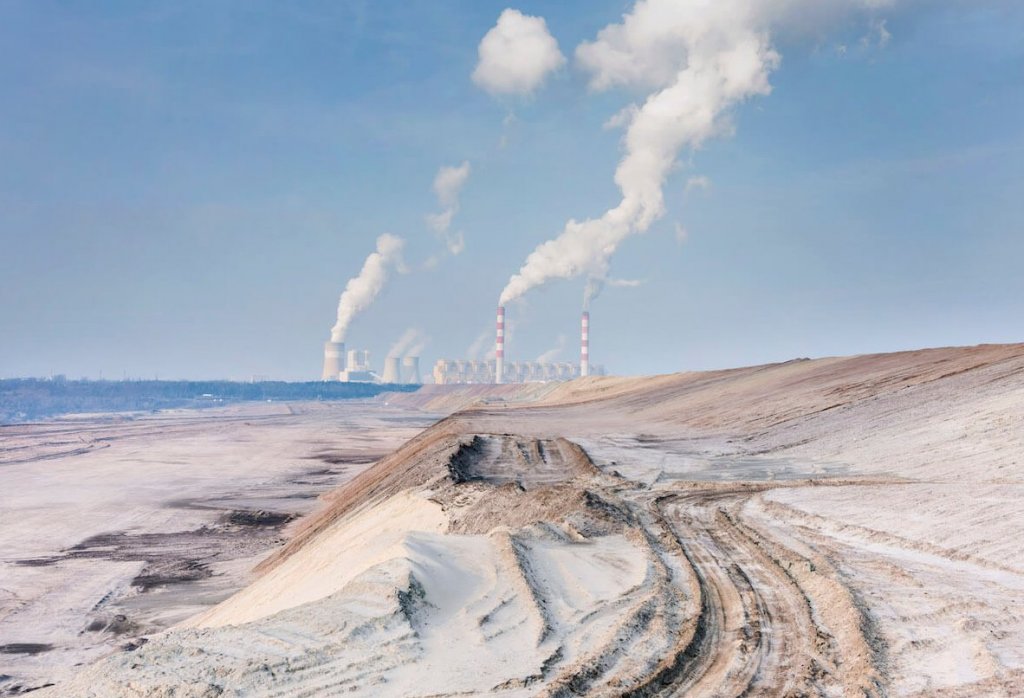
Almost a decade ago, Polish Energy Group withdrew from the plans to build the installation in Bełchatów (the CCS facilities there were to capture only 1.8 million tonnes of CO2 of the 30 million tonnes emitted annually by the power plant), because it did not receive the expected European or state financial support. The construction of the installation was expected to cost 600 million euros, and the cost of capturing and injecting each tonne of CO2 into the ground was estimated at around 60 euros, while, in the European Emissions Trading System, the fee for releasing one tonne of this greenhouse gas into the atmosphere was four times lower. Now that it is at 85 euros, such an investment seems more profitable. But today, even the Polish government is planning to slowly phase out coal burning in the energy sector. Bełchatów may not last to see its CCS.
Iceland’s Orca catches CO2 at ten times the price of the proposed Bełchatów installation, but it does so directly from the air instead of from the pipes leading to chimneys, allowing it to also capture non-local emissions. This is important, because carbon dioxide mixes well in the atmosphere and spreads quickly around the world. Even if the cost of Orca’s successors is reduced to the coveted one hundred dollars per tonne of CO2, the capture of nearly eight billion tonnes per year by mid-century, as laid out by the International Energy Agency, will cost taxpayers a neat 800 billion dollars, or nearly. That’s almost 1 percent of the current global GDP.
But how high should we estimate the costs of abandoning the carbon transformation and decarbonization of the economy? What will be the cost of a climate catastrophe?
Living air treatment plant
I reached out to Professor Bogdan Chojnicki not about Bełchatów, Iceland, or futuristic projects in the USA and Scotland, but about the role of ecosystems in the absorption of atmospheric carbon dioxide. Maybe there’s a cheaper way to get the excess greenhouse gases out of the atmosphere? After all, in 2017, during the tenure of Environment Minister Jan Szyszko, Poland promoted the idea of “forest carbon farms”, allegedly absorbing a large part of Polish CO2 emissions.
How does one even study how much carbon ecosystems absorb and how much they emit into the atmosphere? “In the case of power plants and other industrial plants, the calculation of carbon dioxide emissions is quite simple because it depends on the amount of fossil fuels they burn,” explains the scientist. Let’s recall: a kilogram of burnt carbon (which in various proportions occurs in fossil fuels) means almost four times that mass of CO2 emitted. “However, when studying the exchange of matter between the atmosphere and ecosystems, we must rely on direct observations,” the scientist continues. “There are various methods. The most advanced one is used in the open air and is called the eddy covariance technique. A sensor positioned in a particular place observes eddies in the lower layer of the atmosphere. Due to the fact that air flowing over a given surface acquires its characteristics, it is possible to measure changes in the concentration of gases in it, for example carbon dioxide. The eddy covariance technique therefore shows the net flow of matter and heat from the atmosphere and back, averaged across the entire ecosystem,” Professor Chojnicki explains.
Then there’s the chamber method. “We can enclose a portion of air around a piece of the ecosystem, be it at the level of a single leaf, needle, or a whole tree, and measure whether the carbon dioxide concentration in it is falling or rising. Of course, it’s a point measurement. So in order to study the exchange of matter in the entire ecosystem, it is necessary to carry out many such measurements and then average their results.” The scholar is constantly looking at a point below my eyes, I suspect that’s where he sees my face on the screen.
What do these measurements show? They allow the researchers to determine that in Poland each hectare of forest consumes on average from 4.5 to 5 tonnes of CO2 per year. So should we plant trees, shrubs, and other plants wherever we can, and let the Earth grow over?

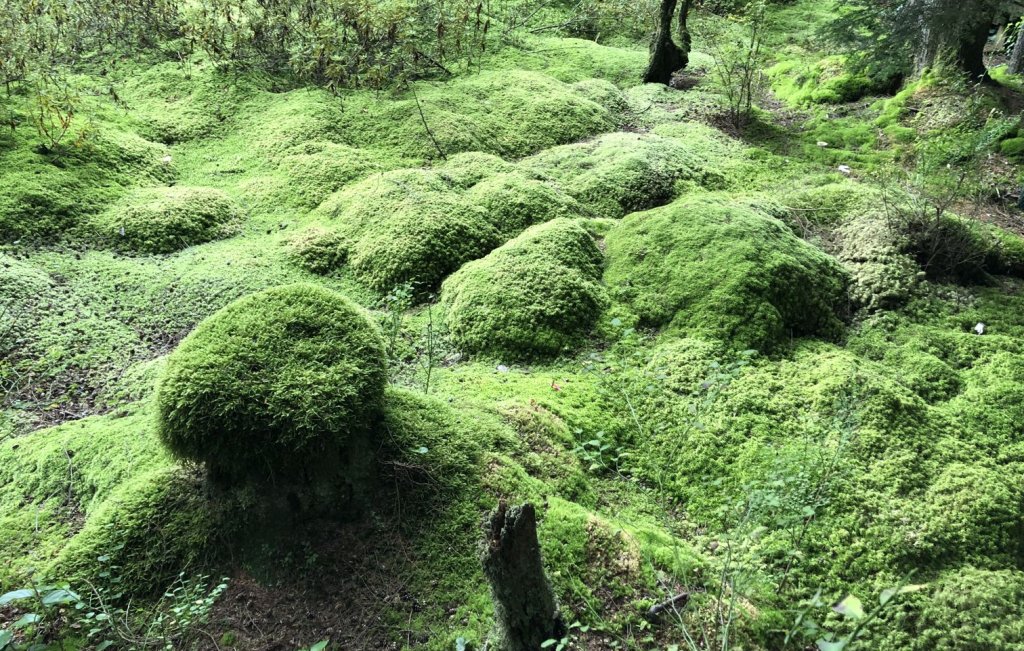
In 2019, a team led by the ecologist Thomas Crowther, currently a thirty-five-year-old assistant professor at the Federal Institute of Technology in Zürich (ETHZ) and a United Nations advisor on restoration of ecosystems, published the results of its calculations in Science. Outside of all the extant forests in the world, as well as urban and agricultural areas, i.e. in the so-called wastelands, new forests could occupy an additional area of nine million square kilometres. That’s almost the land area of the United States. According to the authors of the publication, the forested area of the Earth would thus increase by over a quarter. By the time the new forests matured, they would have absorbed 205 billion tonnes of carbon out of the air. This is almost one third of what we have sent into the atmosphere since the Industrial Revolution. And nearly a quarter of all the carbon circulating in it today, contributing to the blanket of greenhouse gases.
Crowther repeated his results at the conference on direct CO2 capture which Climeworks organized in Zürich in mid-September of 2021 (the same conference during which doctors Wurzbacher and Gebald touted their technology). He emphasized that trees should not be planted, but allowed to grow naturally. This view is generally shared by biologists. When in mid-2020 the European Commission proposed a programme to plant three billion trees by 2030, scholars from Poland, Sweden, and Germany sent a letter of protest to the journal Science. “A tree plantation is not a forest!” said Professor Nuria Selva, the main author of the letter and a biologist from the Institute of Nature Conservation of the Polish Academy of Sciences in Kraków. Trees can be planted in cities, but in natural forests they should propagate on their own.
People often do not understand this, because they are mainly familiar with timberlands, in which monocultures of trees, in Poland usually pines or spruces, grow in straight rows in a military fashion. Natural forests, in contrast, are not only biodiverse, but also adapt themselves to climate change and, by varying their species composition, are better able to cope with diseases and parasites. And you don’t have to plant them, just don’t disturb them. Such forests are also beneficial for local communities because they retain water, protect the soil from erosion, and generally cool the local climate [Editor’s note: Filip Springer wrote about it in Pismo, issue 12/2020].
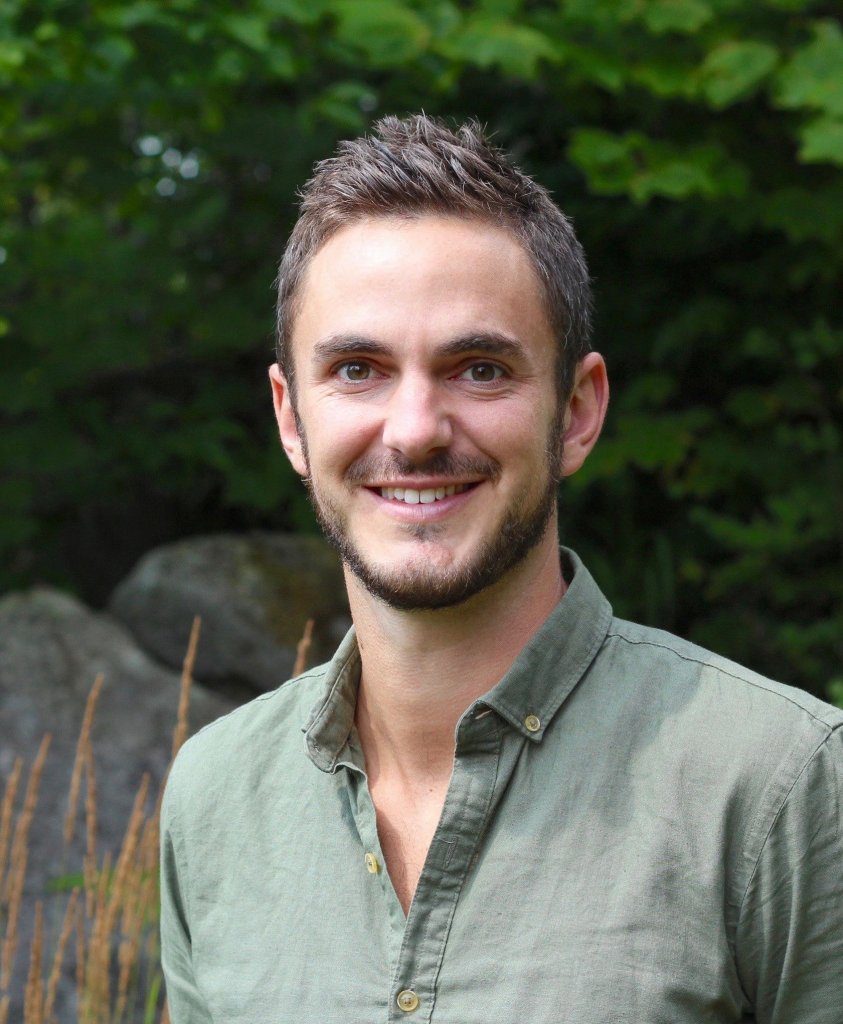
But let’s go back to Zürich. It is true, Crowther admits ahead of the sceptics, that the new forests will take at least a few decades to grow, while we need them today. But we are still 30 years away from a sufficiently mature technology of capturing atmospheric carbon dioxide. Nature, meanwhile, is already here. Just let her do her thing. “I am an optimist!” he declares, earning applause from the audience. Later, I ask him (by e-mail, the scholar is too busy to talk) why he is so optimistic.
Human ingenuity and passion makes me hopeful,” he replies. An optimist, indeed. “We’re starting to see a true global movement to support sustainable ecosystem restoration – not just planting trees, but restoring nature to its normal state.
~ Thomas Crowther
One tool intended to monitor and stimulate this global movement is a website with the clever domain name Restor.eco, funded by the Crowther Lab at ETHZ. It is a platform that is supposed to combine the wildlife programs scattered all over the world, as well as maintain quality control. “I’m confident that in the coming years, biodiversity metrics will be advanced enough to create a biodiversity market,” writes Professor Crowther. In other words, preserving biodiversity is supposed to become good business, just like carbon capture by CCS or DAC installations. Countries will set up financial support schemes (for example through tax breaks) for citizens and companies supporting the environment. It is conceivable that such financial instruments could be traded. Those who do not meet the standards of biodiversity protection would have to buy “green credits” from those who meet them in excess. Just like CO2 emission permits are being traded today.
Renaturalisation of the world’s previously degraded regions should therefore be financially rewarded, just as the emission of greenhouse gases is already financially penalised, although still to a very limited extent.
Costa Rica is one of the countries that has already – and with great success – introduced instruments promoting renaturalisation. David Attenborough praises it as a model in A Life on Our Planet. Back in the 1940s, as many as three quarters of this small Central American country were covered by rainforests, cloud forests (tropical montane forests with persistent fog), and coastal mangrove forests. In the next four decades, most of them were felled for crop and livestock farming. In 1985, forests accounted for only a quarter of Costa Rica’s surface area. For comparison, forests, primarily timberlands, cover almost one third of Poland.
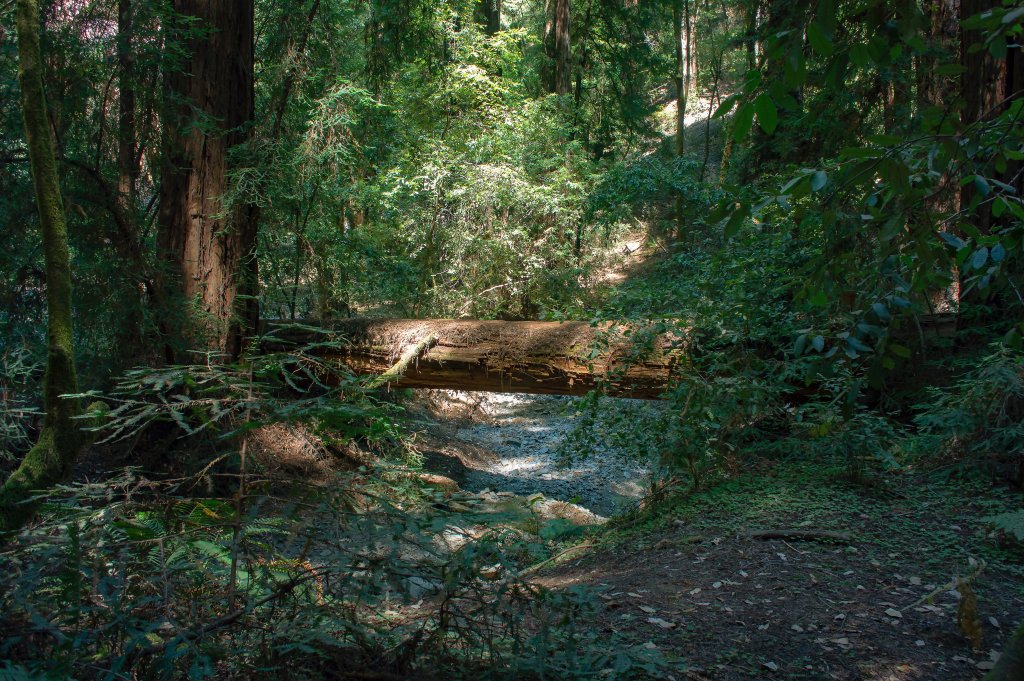
A decade later, the government in San José decided to stop this plunder, giving Costa Rican forests financial value. It introduced a payment programme for so-called forest ecological services, which include carbon absorption, water retention, biodiversity protection, and preserving natural landscapes that would attract tourists. Every landowner who abstained from further felling and allowed their land to grow wild received from 22 to 42 dollars of annual compensation per hectare. Meanwhile, the active cultivation of land for cattle farming brought from 8 to 125 dollars per hectare per year. Many Costa Ricans chose the leisurely option. As a result, forests now cover more than half of the country, and a quarter of it is covered by national parks and nature reserves. As befits tropical forests, Costa Rican ones are bursting with life. They occupy only 0.03 percent of the Earth’s surface, but are home to 5–6 percent of its animal and plant species. Simultaneously, ecotourism has become the most important branch of the country’s economy.
Thomas Crowther says that the more natural the ecosystems, the more carbon they can remove from the atmosphere. As you might expect, his ideas are met with criticism, also in the scientific community. Back in 2019, Science published a letter by scholars from Germany, Kenya, and the Democratic Republic of the Congo, in which they accused Crowther’s earlier publication (about the claim that it is easy to reforest an unused area the size of the USA) of omitting a few inconvenient facts. They pointed out that optimistic estimates of how feasible it would be to surrender such a portion of the Earth to forests omitted obvious environmental and socio-economic constraints. First of all, the climate and other natural conditions prevailing in many parts of the world are not conducive to forests. The scholars mentioned the Arctic regions of Eurasia and North America, deserts and semi-deserts, as well as savannahs. They also noted that even where forests could grow, they do not because human activity has excessively degraded the soil. The renewal of the topsoil by natural processes takes thousands of years.
The authors of the rebuttal saved their strongest counterargument for last. Crowther’s team blithely proposed to reforest lands inhabited by over 2.5 billion people (nearly a third of humanity), including entire cities, such as Kinshasa, the capital of the Democratic Republic of the Congo. Crowther himself dismisses these criticisms, calling them a misunderstanding and insisting that his idea only concerns wastelands.
Professor Bogdan Chojnicki is also sceptical about the possibility of removing excess carbon dioxide by means of rewilding or planting trees. “If it were so simple, why are these trees, which should grow in many places, not yet doing so?” he shakes his head. “After all, if we allowed them to do so, by taking the pressure off their environment, they’d have grown by now. Evidently, we need the lands once naturally covered by forests. And even if we plant some trees someday, there is no guarantee that after 100–120 years (which is how long growth takes in Polish farmed forests) we will not cut them down and burn them. If we burn them, all the carbon they’ve accumulated for decades will fly back into the atmosphere. Of course, we can also store it in wooden structures, such as buildings or furniture, and use those for hundreds of years. But such a way of using any objects goes completely against the current habits and the economy which is all about turnover and growth. This growth depends on consumers who constantly buy and fuel the economy.”
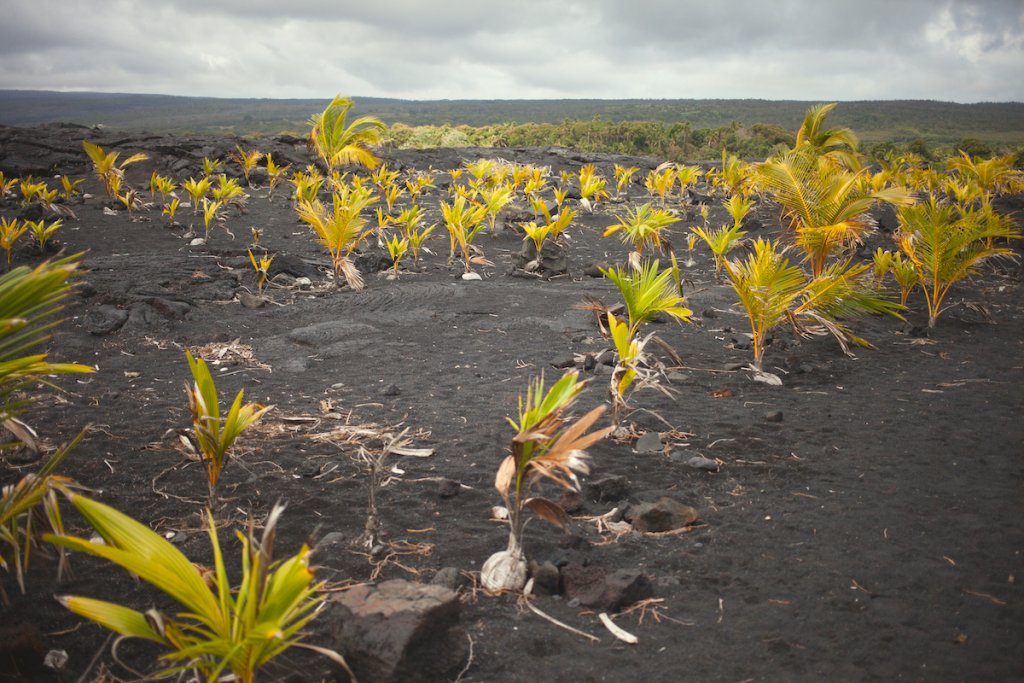
Professor’s pessimism may be caused by the drastic consequences of what came to be known as lex Szyszko – an amendment to the Act on Nature Protection passed in December 2016 at the behest of the then Minister of the Environment. According to estimates from 2017 by Professor Zbigniew Karaczun, an expert in environmental management from the Warsaw University of Life Sciences, Poles, given by Jan Szyszko a free pass to cut down trees on their properties, got rid of nearly three million trees in the course of a few months. Not until April 2017 did the parliament tighten the regulations, imposing an obligation on property owners to apply to the municipality for a permit.
We cannot know what environmental awareness people will have in the next century. We also do not know what regulations will enforce environmental protection. Perhaps our descendants will consider lex Szyszko a manifestation of their ancestors’ barbarity.
Scientists are debating about the potential for restoring forests to the world and the world to forests, but for now we are going in the opposite direction.
In 2015, Dr Crowther’s team, who worked at Yale University at the time, estimated in Nature that there are currently over three trillion trees growing all over the Earth. Most, as much as 43 percent, are in tropical regions, of which almost one third in the Amazon. The taiga and Boreal forests covering the sub-Arctic regions of Eurasia and North America hold another 24 percent. The temperate zone, including Poland – 22 percent. Estimates from the United Nations Food and Agriculture Organization’s (FAO) report The State of the World’s Forests of 2020 show that all the forests of the world have a total area of nearly 40 million square kilometres. Only a third of these are natural forests.
Is three trillion trees a lot?
Since the agricultural revolution of 11.5 thousand years ago, which gave a strong impulse to civilizational development and demographic growth, almost half of the trees have disappeared from the Earth’s surface. Worse still, according to Crowther’s team, people are now cutting down more than 15 billion trees every year around the world, a forest of about 200,000 square kilometres. If all these trees grew side by side, they would occupy almost two-thirds of Poland. According to the FAO, just between 1990 and 2020, we lost 4.2 million square kilometres of forest, an area equal to the entire European Union. The main driving force behind the destruction of forests is the expansion of arable and livestock lands.
Hence, in November 2021, the European Commission proposed to the EU countries a regulation to prevent deforestation caused by them beyond their borders. The aim is so that products imported into the EU, such as soya, beef, palm oil, lumber, cocoa, and coffee, are not cultivated to the detriment of forests. Importing those that cause such damage would be illegal.
That’s not all. Many forests have become net emitters of carbon dioxide and methane because of human-caused factors, such as climate change and major fires. In other words, they release more carbon into the atmosphere than they take out. This means that these forests do not flourish, nor spread to new territories, nor mature ecologically into more complex ecosystems, but that they degenerate. Let’s remember: life exists because it exchanges matter among its actors, mainly carbon, on which all earthly organisms base their structures. Ecosystems which lose more carbon than they gain are dying.
These include forest ecosystems recognised by UNESCO (the United Nations Educational, Scientific and Cultural Organization) as treasures of the world’s natural heritage. Just before the annual COP26 climate summit in Glasgow in October 2021, UNESCO, the World Resources Institute, and the International Union for Conservation of Nature published a joint report which warned that as many as ten World Heritage Forests had emitted more carbon than they had absorbed over the past twenty years. During this period, they lost a total area of 35 thousand square kilometres. Among them are Indonesia’s tropical rainforests, the Blue Mountains in Australia, the Río Plátano Biosphere Reserve in Honduras, Yosemite National Park and Grand Canyon National Park in the US, the Barberton Makhonjwa Mountains in South Africa, and the Uvs Lake Basin on the border between Russia and Mongolia. The Amazon, perhaps the most iconic forest in the world, was not on this alarming list. However, another study, published in July 2021 in Nature, shows that the south-eastern part of the forest has indeed become a net emitter of carbon dioxide. If we can’t defend the Amazon against destruction, what forests can we defend?
Deforestation and degradation of Brazillian Amazon / Google Earth Timelaps
According to the State of the World’s Trees published in September 2021 by the International Association of Botanical Gardens, 142 species of trees known to science have already died out, and as many as 30 percent of almost 60,000 such species are at risk of extinction. Human logging, parasites, and diseases, as well as the consequences of global warming, are the biggest contributors. The largest number of tree species grow in tropical forests, i.e. those that are currently the most endangered by humanity. Another challenge are forest fires exacerbated by global warming. In 2020, more than three thousand square kilometres of forest went up in smoke in the European Union, of which 40 percent in the Natura 2000 areas. That’s twice as much as the year before. And by the end of October 2021, the record was already broken again – almost five thousand square kilometres of forest had burned.
In this situation, UNESCO’s statement that the forests included in the World Heritage List exceed twice the area of Germany, and 257 of all UNESCO natural objects remove 190 million tonnes of carbon from the atmosphere every year, is a cold comfort. These areas are simply not big enough to be important in balancing anthropogenic emissions of CO2 – even those that will remain after a possible sharp reduction in greenhouse gas emissions. And in spite of being protected in theory, they are still subject to strong pressures from humankind.
Fortunately, there is also a bit of good news. Forests heal quickly, as soon as we leave them alone and let them grow. This is shown not only by the example of Costa Rica, but also by the analysis published in Science in December 2021. Its authors concluded that 20 years is enough for the so-called secondary tropical forests growing on abandoned agricultural land to regain as much as 78 percent of the value of old forests, calculated from twelve attributes measuring the well-being of forest ecosystems, including their ability to bind atmospheric carbon. After 120 years, such forests reach 90 percent of the biomass of natural ecosystems.
One hundred and twenty years is really a short time. Less than five human generations. The example of Costa Rica, a poor country that over a quarter of a century was able to reverse the process of destroying its tropical jungle, shows how much can be achieved. I will take another look at Costa Rica in the fourth, final part of Pismo’s Lens Earth series.
“My favourite ecosystem that captures carbon dioxide from the atmosphere are not forests, but peat bogs,” Professor Bogdan Chojnicki smiles gently. “They do not absorb much of it, a maximum of 2.5 tonnes per hectare per year, but they store it for thousands of years. Unless humans destroy them,” the scholar trails off.
Why would humans destroy peat bogs? To use peat for garden soil (which is still done in Poland) or for fuel (the Scots smoke barley malt with peat to make whisky). But mostly to capture more farmland and pastures. In Poland, draining swamps was started in the 16th century by settlers from Holland and Friesland, whose ancestors used to do the same in the Netherlands. Since then, we have lost nearly 85 percent of healthy peat ecosystems by surface area, although compared to Western Europe we are still “behind” [Editor’s note: Filip Springer wrote about it in Pismo, issue 12/2019].
Researchers estimate that all the degraded wetlands in the world emit two billion tonnes of carbon dioxide a year, or more than 5% of the anthropogenic CO2 emissions. But even today, peatlands, which occupy barely 3 percent of land on Earth, store twice as much carbon as forests, which take up ten times more land. In their wetland ecosystems, they collect a total of one third of all organic carbon present in the soil, and it is estimated that the entire Earth’s soil contains nearly 2.5 trillion tonnes of carbon, which is about three times more than is currently in the atmosphere.
Nearly 1.7 trillion tonnes of carbon are trapped in frozen soil, which until a few years ago we unanimously called permafrost (now it is only long-term-frost, I guess). Researchers are afraid that with global warming, it will be increasingly thawing, and the microorganisms that awaken in it will begin to process the carbon that had been trapped there for thousands of years. Doing so, they will release huge amounts of carbon dioxide (if they are aerobic microbes) and methane (if they are anaerobic), which will accelerate global warming even more. We can avoid this scenario only if we severely bring down the Earth’s fever – to 1.5 degrees Celsius, as we have discussed.
In order to do this, we must, among other things, protect, as well as remediate and restore, active bogs (i.e. those located outside of the permafrost). As Professor Chojnicki explains, everything depends on the groundwater level: “The optimal carbon-absorbent environment for wetlands requires water 10–15 centimetres below ground level. Deeper groundwater levels lead to carbon dioxide emissions. Shallower – to methane emissions, since they favour anaerobic organisms, and the by-product of their metabolism is methane.
It is a stronger greenhouse gas than CO2, but fortunately its molecules persist in the atmosphere for only a dozen years. However, climatologists have calculated that the greenhouse potential of methane, spread over a hundred years (that is, roughly the period in which a CO2 molecule can survive in the atmosphere), is almost thirty times higher than carbon dioxide. Moreover, while the atmospheric concentration of the latter has risen by nearly 50 percent since pre-industrial times, methane’s has risen by as much as 150 percent.
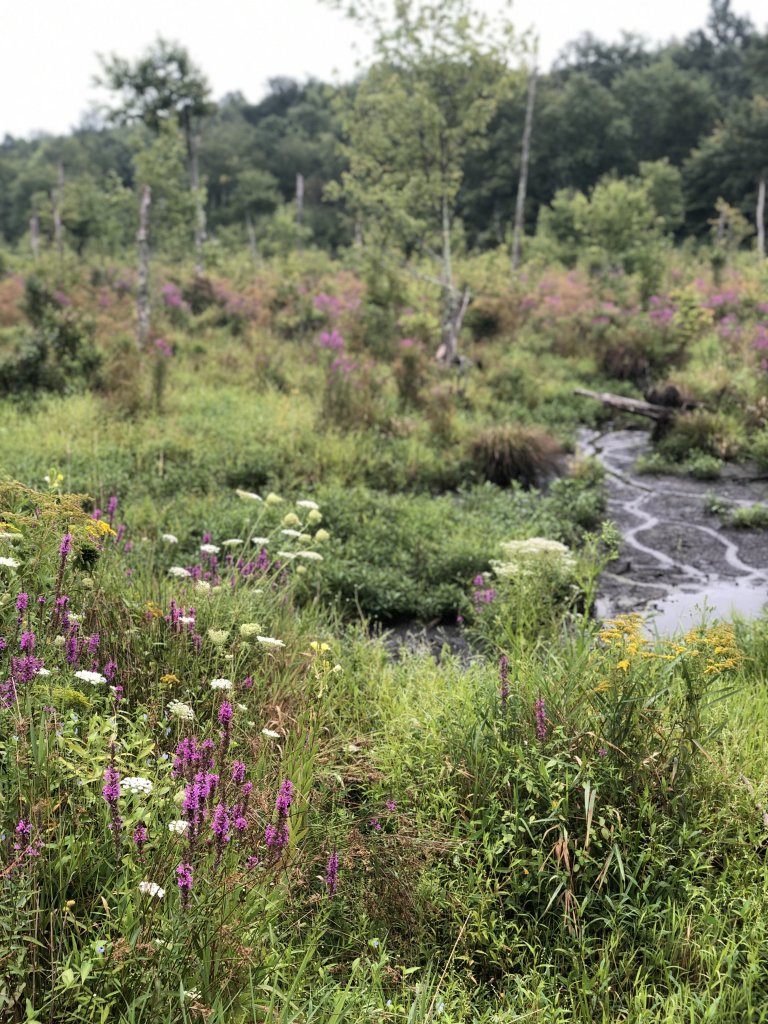
“When the groundwater level in the bogs is optimal, the organisms that live there not only remove carbon dioxide from the atmosphere, but also prevent methane from escaping,” explains Professor Chojnicki. “That’s because so-called methanotrophs live above anaerobes in a buffer layer of oxygenated soil, and for them CH4 is a great source of carbon. These organisms burn it much more efficiently than we do in our boilers,” the scientist laughs.
Peat bogs are the cheapest way to absorb and store carbon, all you have to do is give them proper humidity.
~ Bogdan Chojnicki
How can we do that?
“We should attach the proper value to them, instead of brutally and thoughtlessly exploiting them or draining them just to make the countryside ‘neat’ and ‘tidy’,” the scientist believes. Wetlands should be valued assets, just like forests and other natural ecosystems. They should enter the biodiversity market which Thomas Crowther talks about and which operates in Costa Rica. Is there any chance of that? Time will tell. For the time being, we are unable to respect even the forests, much closer to the human heart than wetlands, viewed as sources of diseases and mosquitoes.
Machines or trees – that is the wrong question
Should we use machines or ecosystems to remove excess carbon from the atmosphere?, I ask Professor Bogdan Chojnicki to settle the matter. “Above all, the anthropogenic emission of greenhouse gases must be severely curbed,” he says. “Carbon capture from the atmosphere using technology or wildlife is just a small addition – nice to have, but no Holy Grail. We won’t solve the problem of global warming this way.”
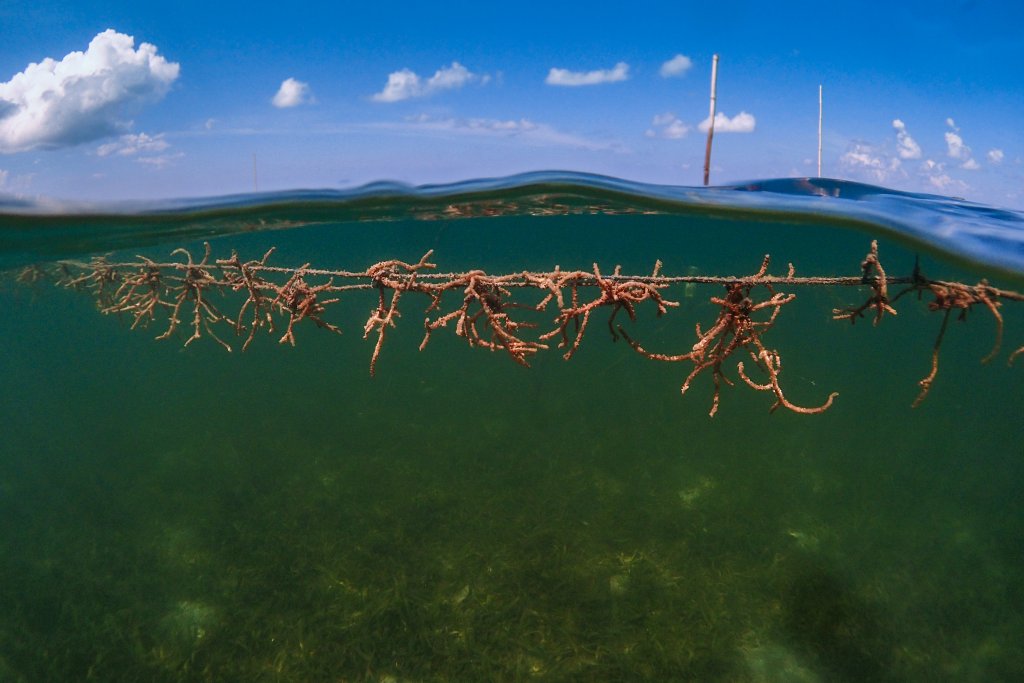
Thomas Crowther agrees, but believes that stopping the climate crisis is so urgent that we need to activate the entire arsenal of human ingenuity. So there is no point in complaining that protecting forests or wetlands and carbon capture technologies are not enough. We should be implementing them together with the necessary cuts in greenhouse gas emissions. “The question is not nature or people. We are facing the connected climate and biodiversity crises because for too long, we have lived in conflict with nature. The opportunity now is to change that relationship and to develop nature-positive economies,” the scholar writes to me in an e-mail.
“Theoretically, the most efficient carbon sink is the agricultural ecosystem,” laughs Professor Chojnicki. “A hectare of dense and fast-growing crops, which are given optimal conditions and which do not have to fight for survival, consumes 10–20 tonnes of CO2 in a year. But after a year or two, all this carbon dioxide removed from the atmosphere returns to it, because people or farm animals digest the crops, and the straw and other residues left in the fields are decomposed by organisms living in the soil.
In spite of this, there are those who see new agricultural solutions as tools in the fight against global warming.
“We are not so much carbon neutral as carbon negative,” bursts Kristins Hafliðasonar, director of Vaxa Impact Nutrition, which since September 2016 has operated an indoor plant for cultivating marine microalgae (phytoplankton – the primary energy producer in aquatic ecosystems) at the Hellisheiði geothermal power plant (where Orca arrived years later). I visit the installation together with the newly befriended journalists from Slovenia. The thundering bioreactor, carbon dioxide bubbling through its tubes and its noise penetrating even through the protective headphones, emits a purple glow. The strange light distorts the colours and gives the impression of being inside a spaceship.
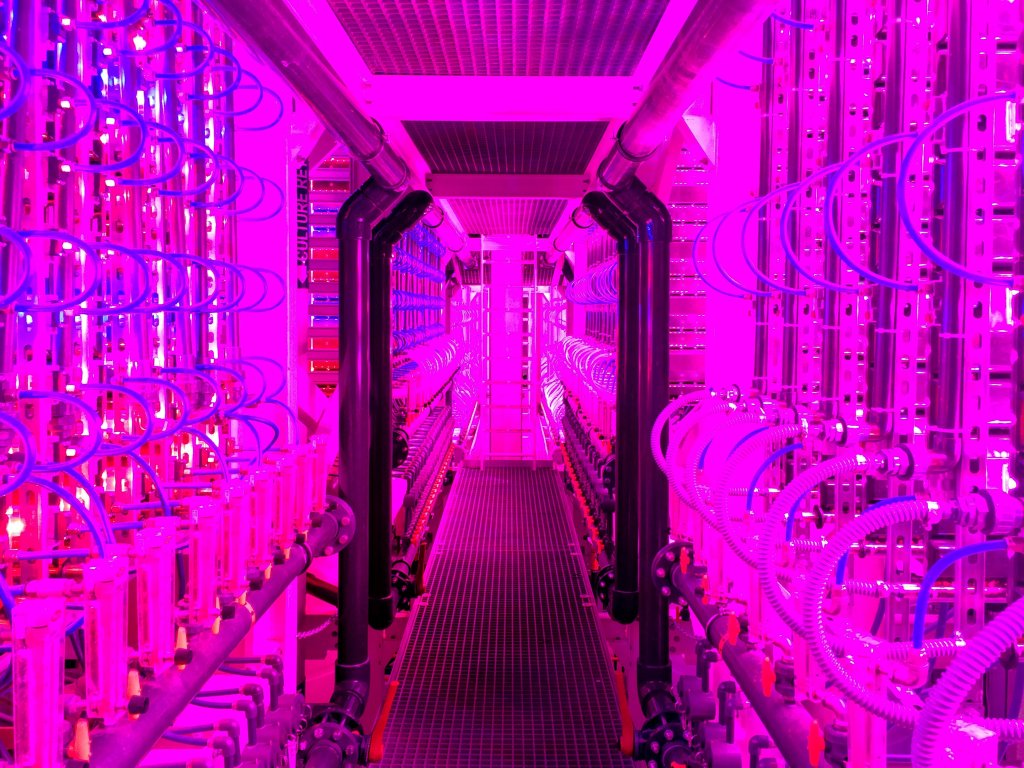
“Our algae like red and blue light, so we use LEDs to give them what they like,” explains Hafliðasonar. It is the mixture of red and blue that is responsible for the purple “haze”. The air smells like ocean. Someone who dislikes the aroma of the sea would say it’s fish. But Hafliðasonar insists that the algae themselves have neither smell nor specific taste. Except for being salty.
In addition to the light, the marine microorganisms circulating inside the bioreactor in a temperature of sixteen degrees Celsius receive an injection of carbon dioxide and cold water with the addition of sea salt from the adjacent geothermal power plant (the installation also draws electricity from it), as well as nitrogen, phosphorus, and a proprietary mixture of other elements and minerals. In return, Vaxa Impact Nutrition squeezes 18 percent of the algal biomass, thick as yoghurt, from each litre of water. By-products are water, 98% of which is reused, and oxygen (phytoplankton and other aquatic plants now account for half of the annual oxygen production on Earth; the other half is up to terrestrial plants).
“We’re already making a profit,” Hafliðasonar makes out. The algae grown here are exported to Turkish fish farms which produce species like sea bass, a favourite in Poland. But Vax Impact Nutrition’s plans are much more ambitious. The company intends to use algae for the production of natural dyes, as well as for Omega fats, which the vaunted marine fish do not synthesize themselves in their bodies, but obtain from the algae. “Except our omega capsules won’t leave a fishy aftertaste in your mouth,” laughs the factory manager.
In the queue for implementation is also the idea of producing algae protein directly for human consumption, which would let our diet bypass several floors of the trophic pyramid and become much more energy efficient. “To get a kilo of meat protein, you need 130,000 litres of water, 9,000 litres if you want soy protein,” Hafliðasonar recapitulates. “A kilo of protein from our algae is obtained using only 16 litres of water,” he says proudly. When the installation reaches full capacity, it is expected to produce a thousand tonnes of algae per year, while consuming tens of thousands of tonnes of carbon dioxide, and generating 60 cents of income on each dollar of investment. “We are not an algae company, we’re a technology company,” insists Hafliðasonar. “We will help to resolve the coming food crisis,” he says.
Researchers at Stanford University have a similar idea for saving the world. In November 2021, in the journal Nature Sustainability, they published calculations of how profitable it would be to produce fodder from… methane. This greenhouse gas is released not only from landfills or sewage treatment plants, but above all from natural gas installations (according to the estimates of the IEA, more than five billion tonnes of CO2 equivalent are released into the atmosphere annually from this source; that is as much as one tenth of all greenhouse gas emissions). American scientists have calculated that using the already mentioned methanotrophs (bacteria that feed on methane), it is possible to produce protein feed, e.g. for fish (currently half of the fish and seafood consumed in the world comes from aquaculture). This idea may seem like a pipe dream for the time being – as its authors themselves admit – but some day, a “fish made of methane” may become a reality.
In the third part of Pismo’s Lens Earth series, we will try to check whether this is science or rather science fiction.
Kristins Hafliðasonar of Vaxa Impact Nutrition laughs that he is a philosopher by education, who has sold his soul to business. He also played football in Iceland’s top league for twenty years, but he did not make a career on the field. “I’m sorry to say, but I was probably the worst football player in Iceland’s history,” he says sheepishly. Then he throws his hands up. “Well, we’ve all had dreams!”.
Text: Tomasz Ulanowski
Graphics and animation: Jan Rosiek
Editing and proofreading of text and charts: Marcin Czajkowski
Publisher: Barbara Sowa
Patrons of the Pismo Lenses series titled Earth are E.ON and mLeasing.



